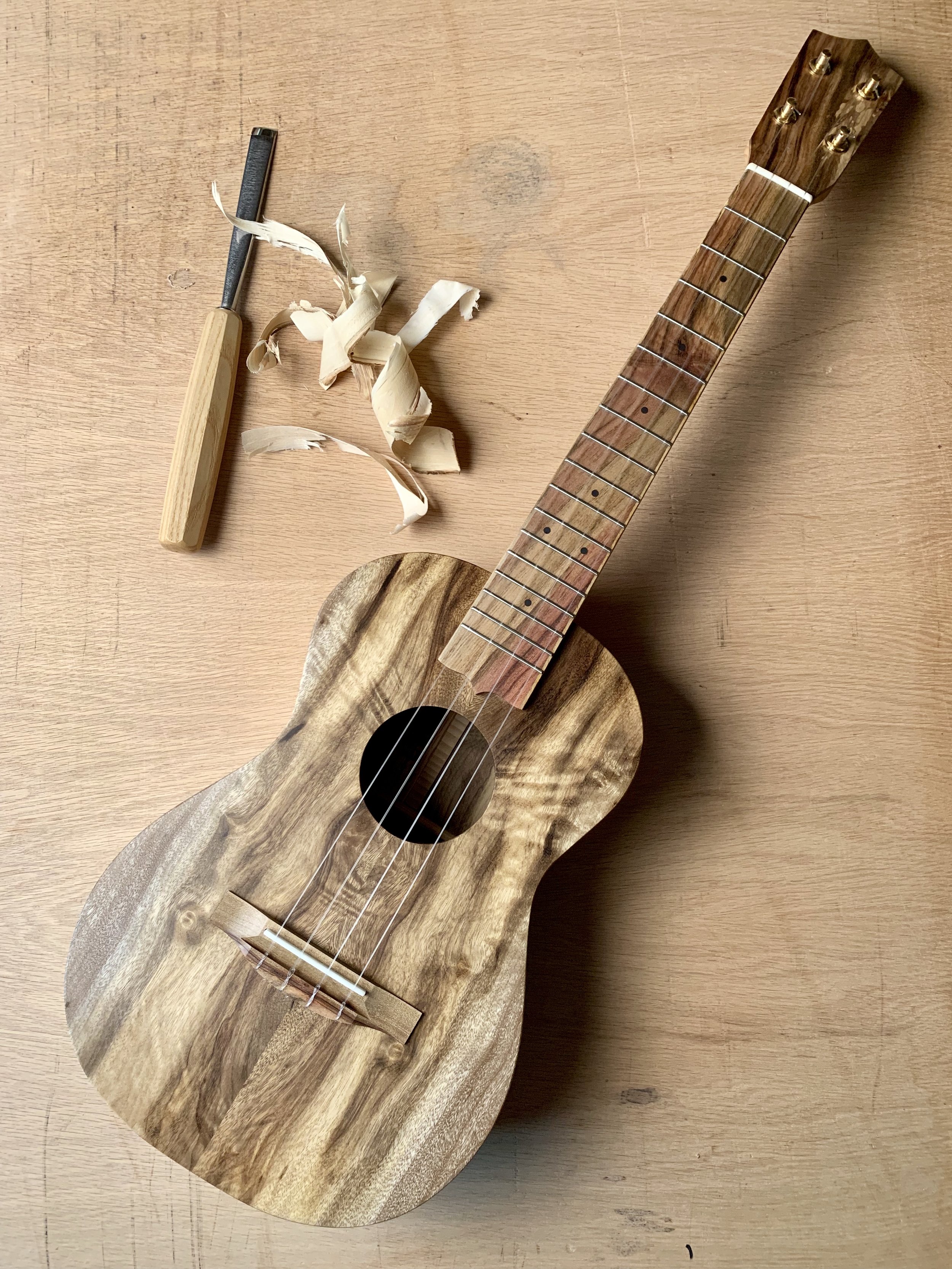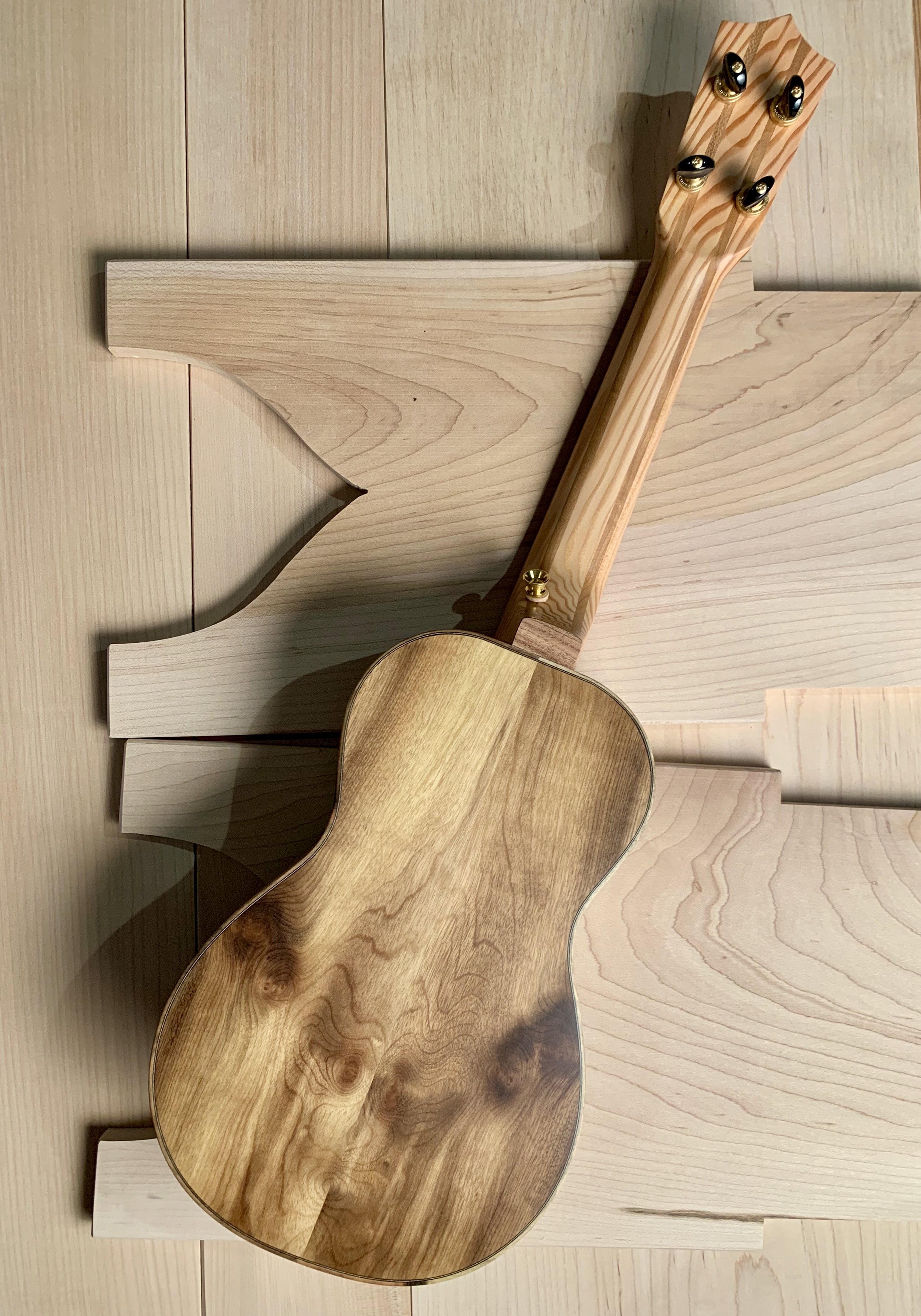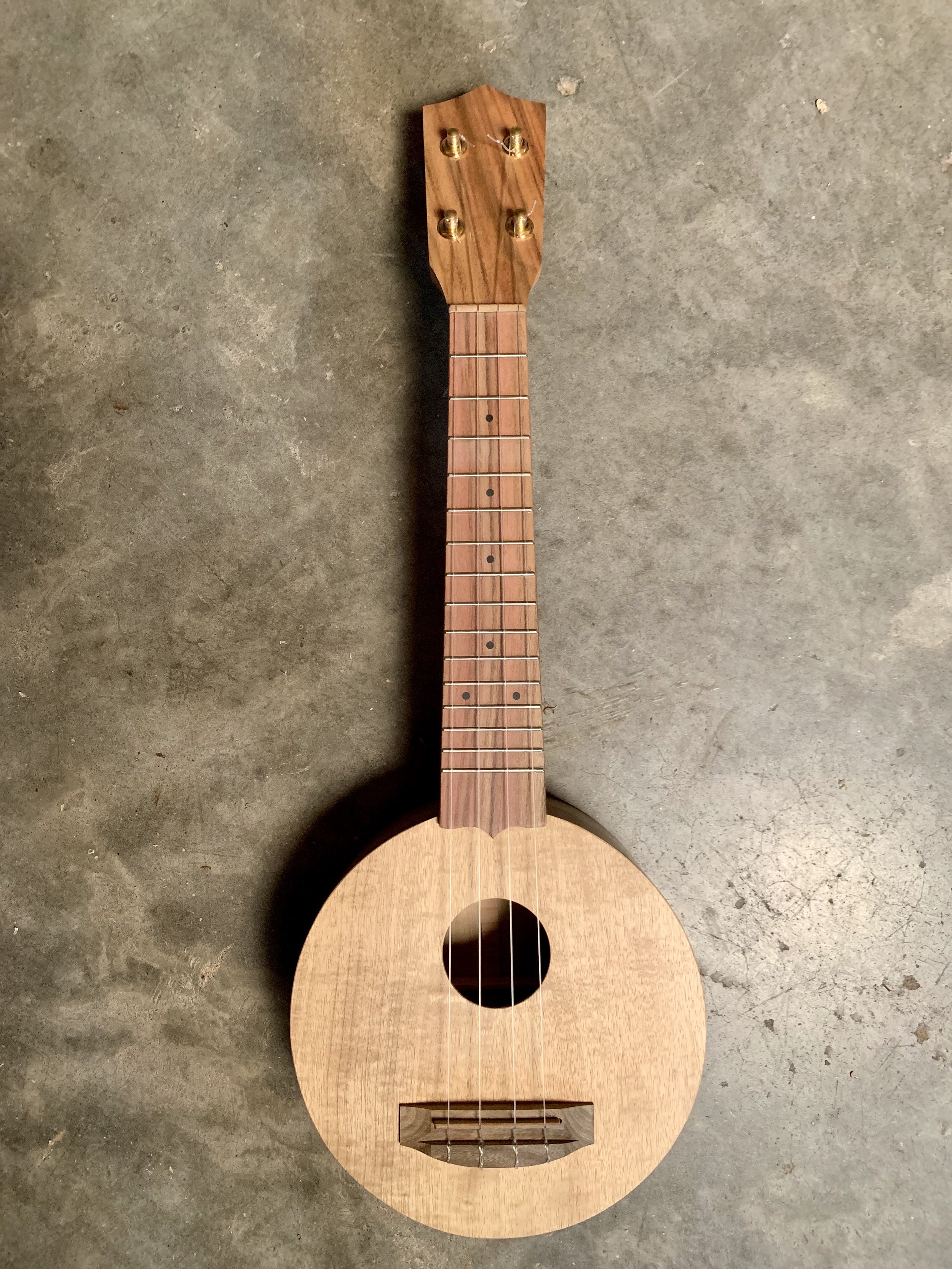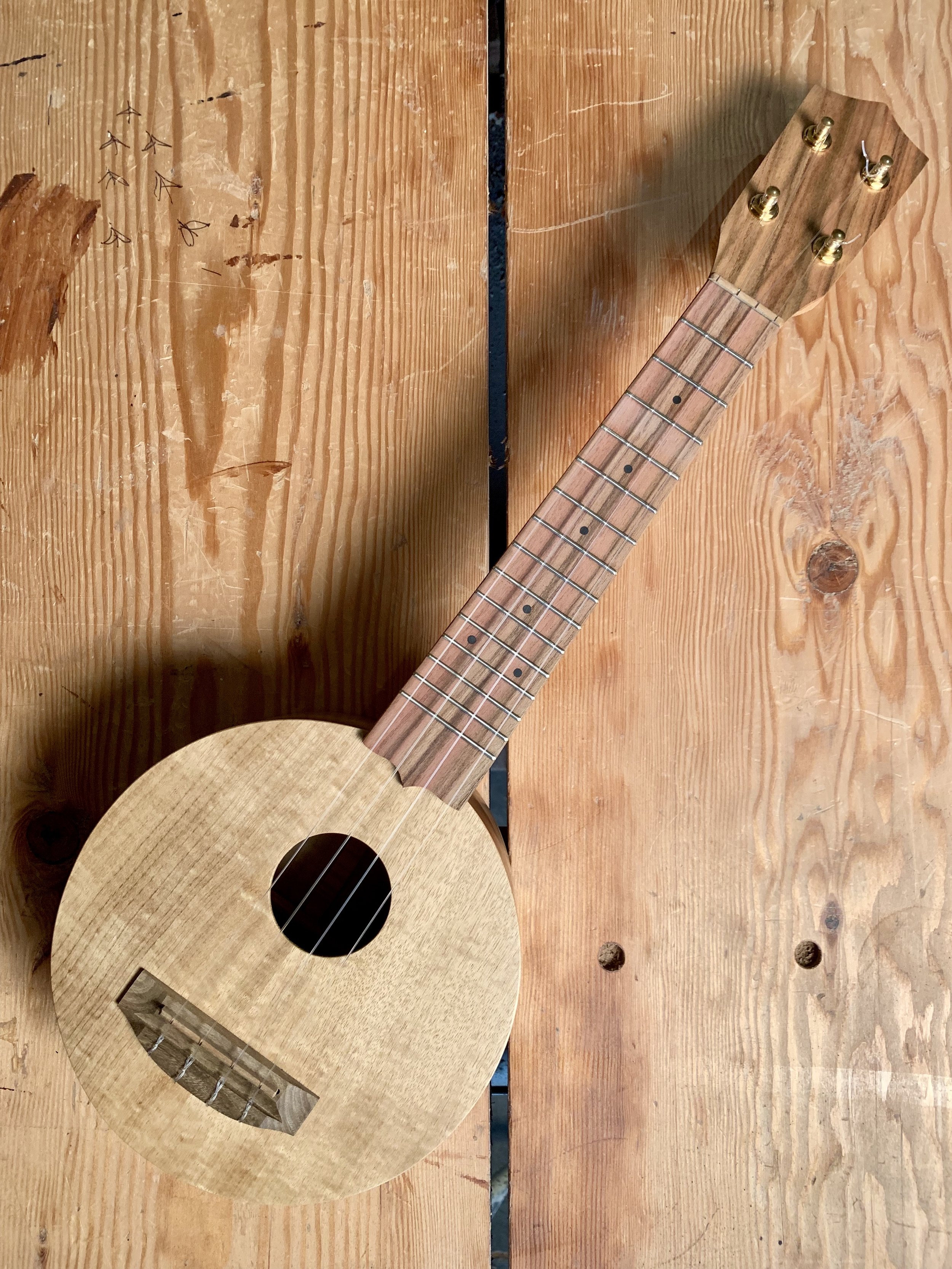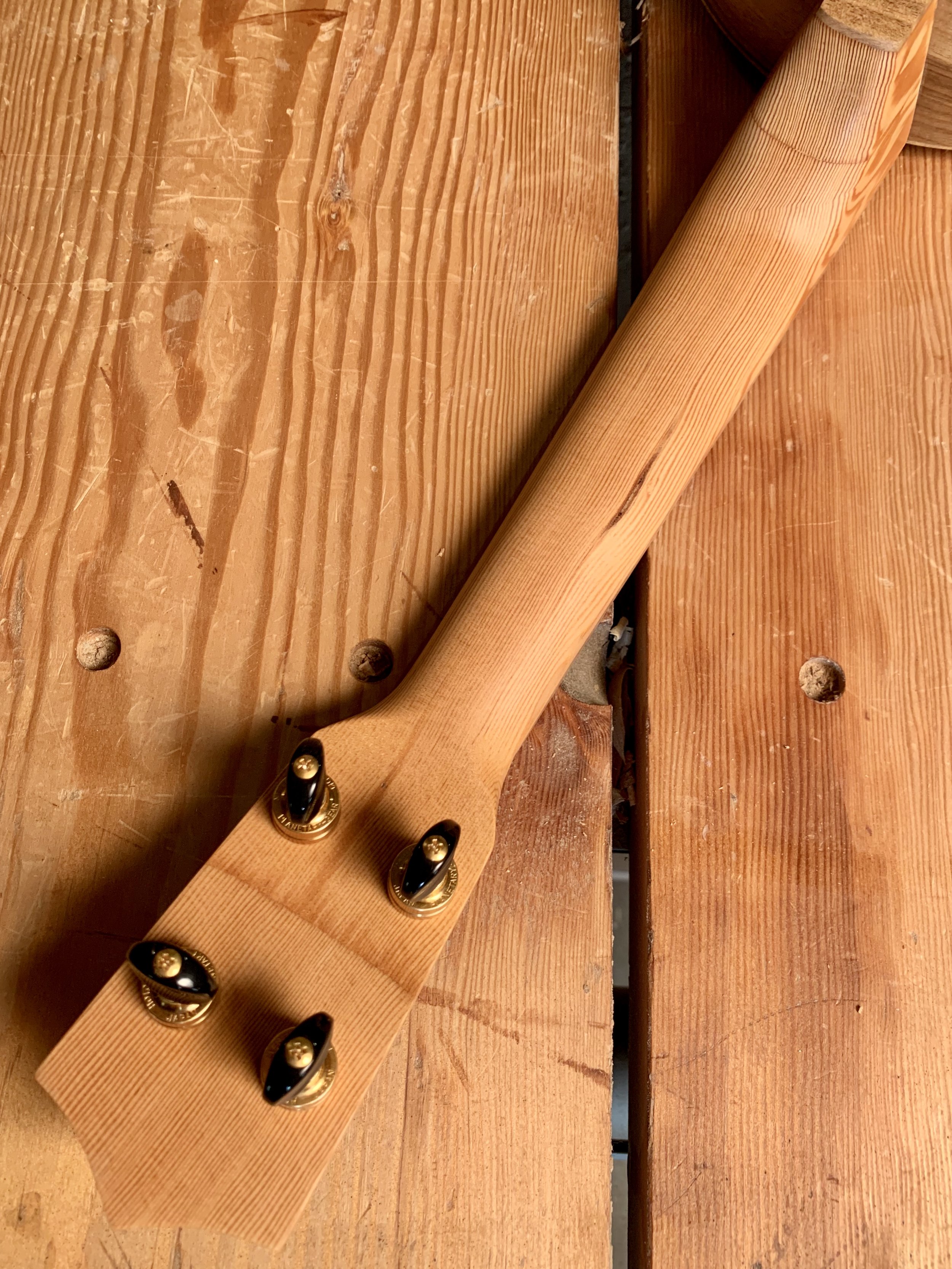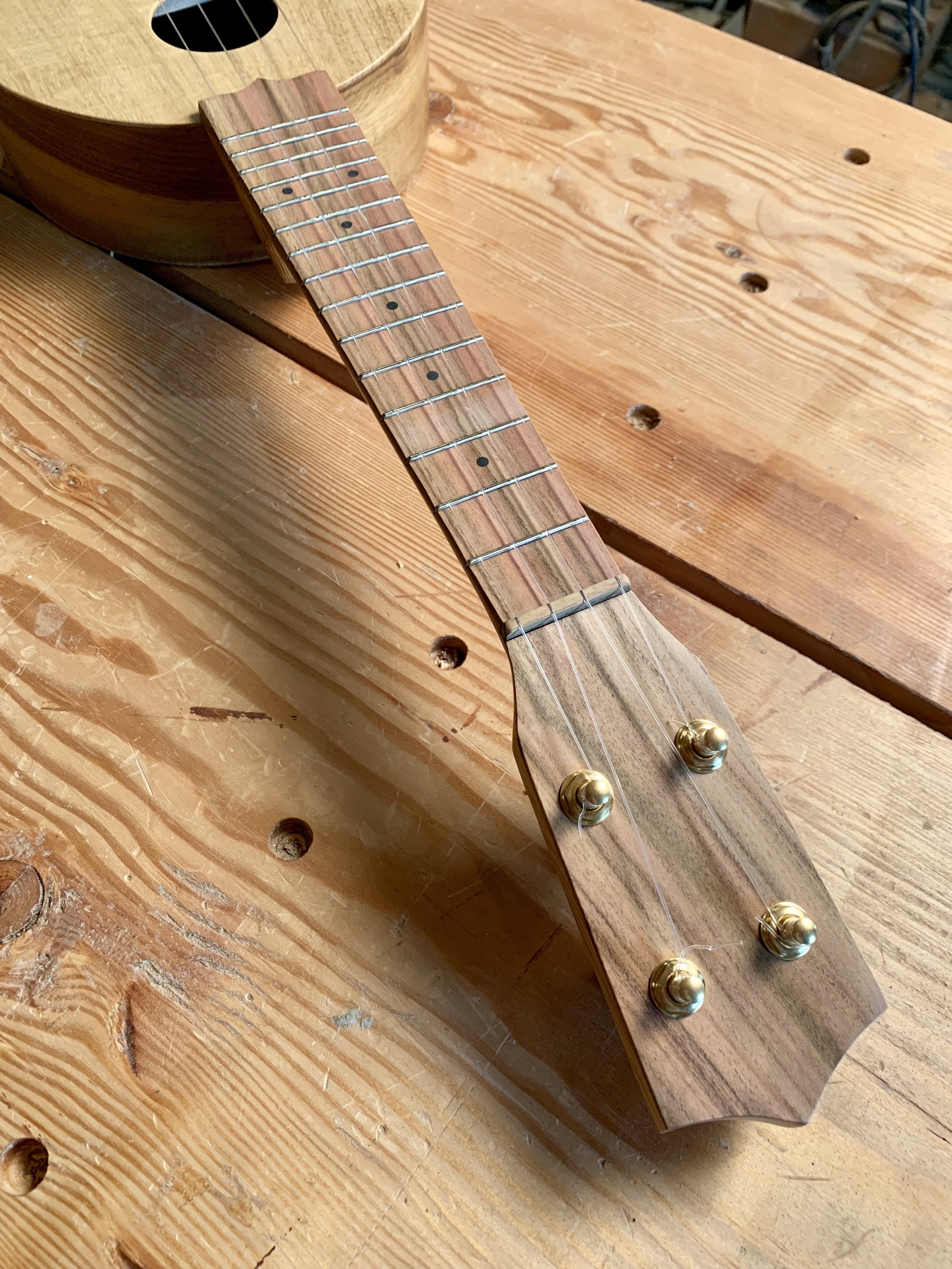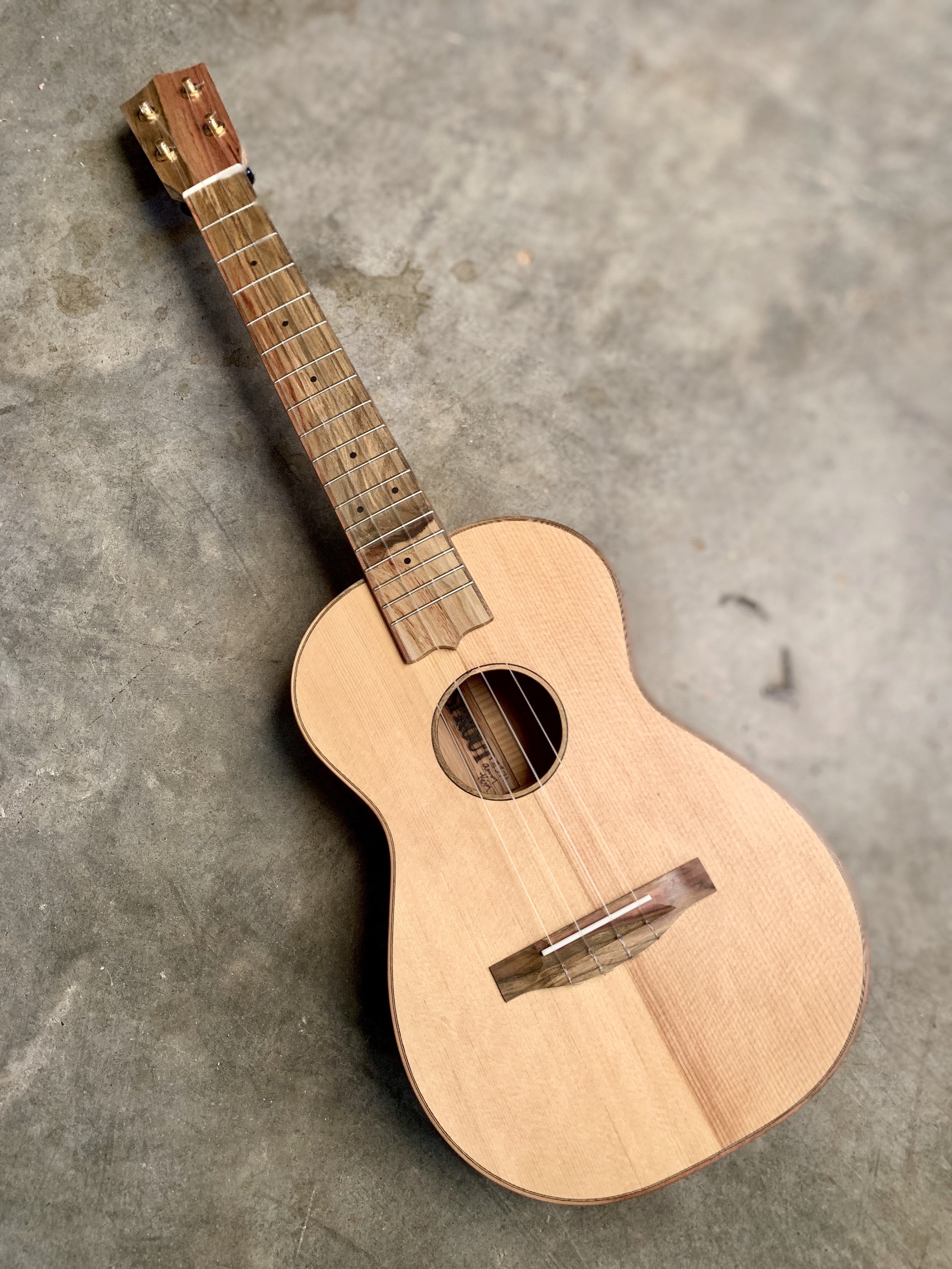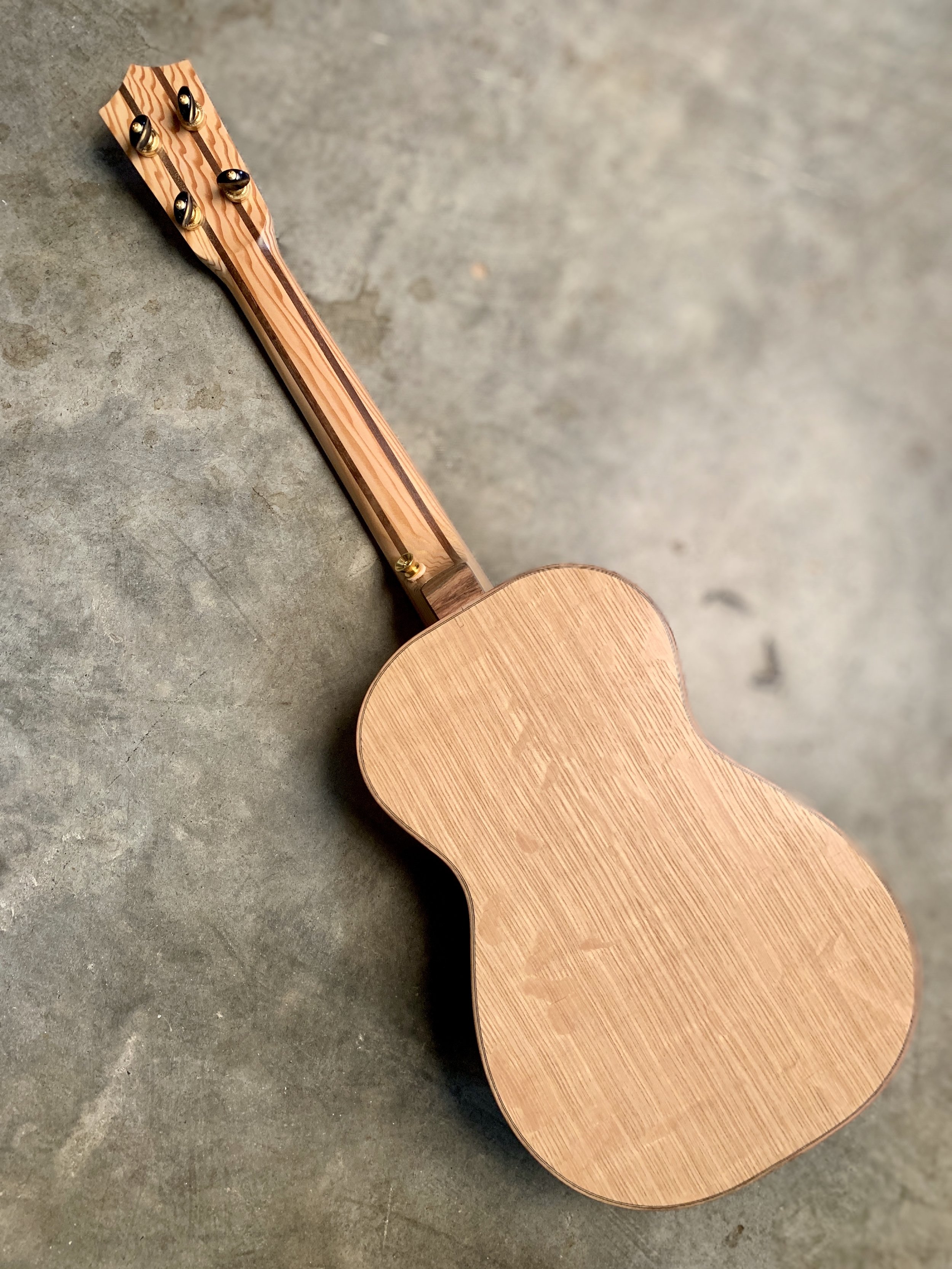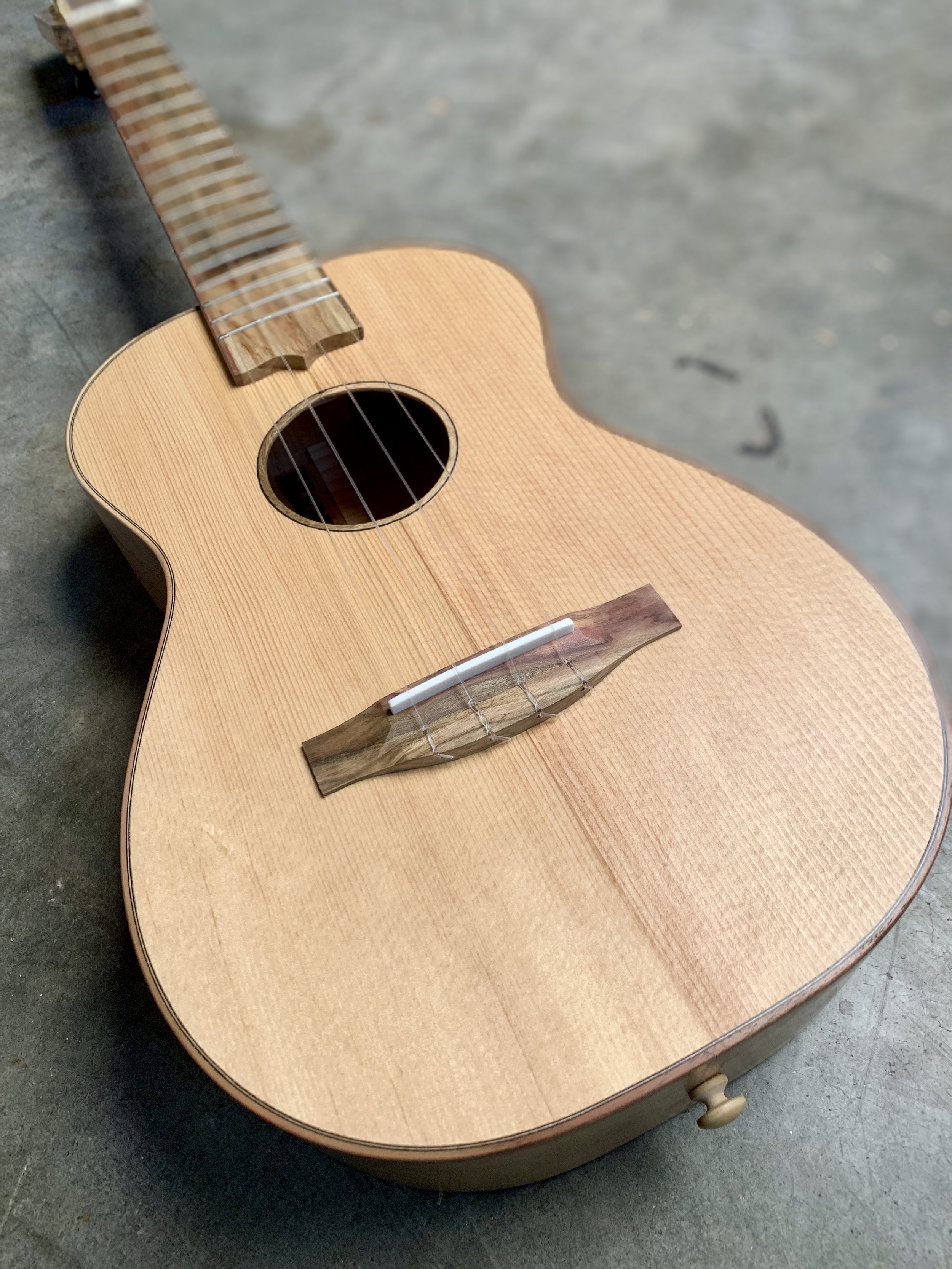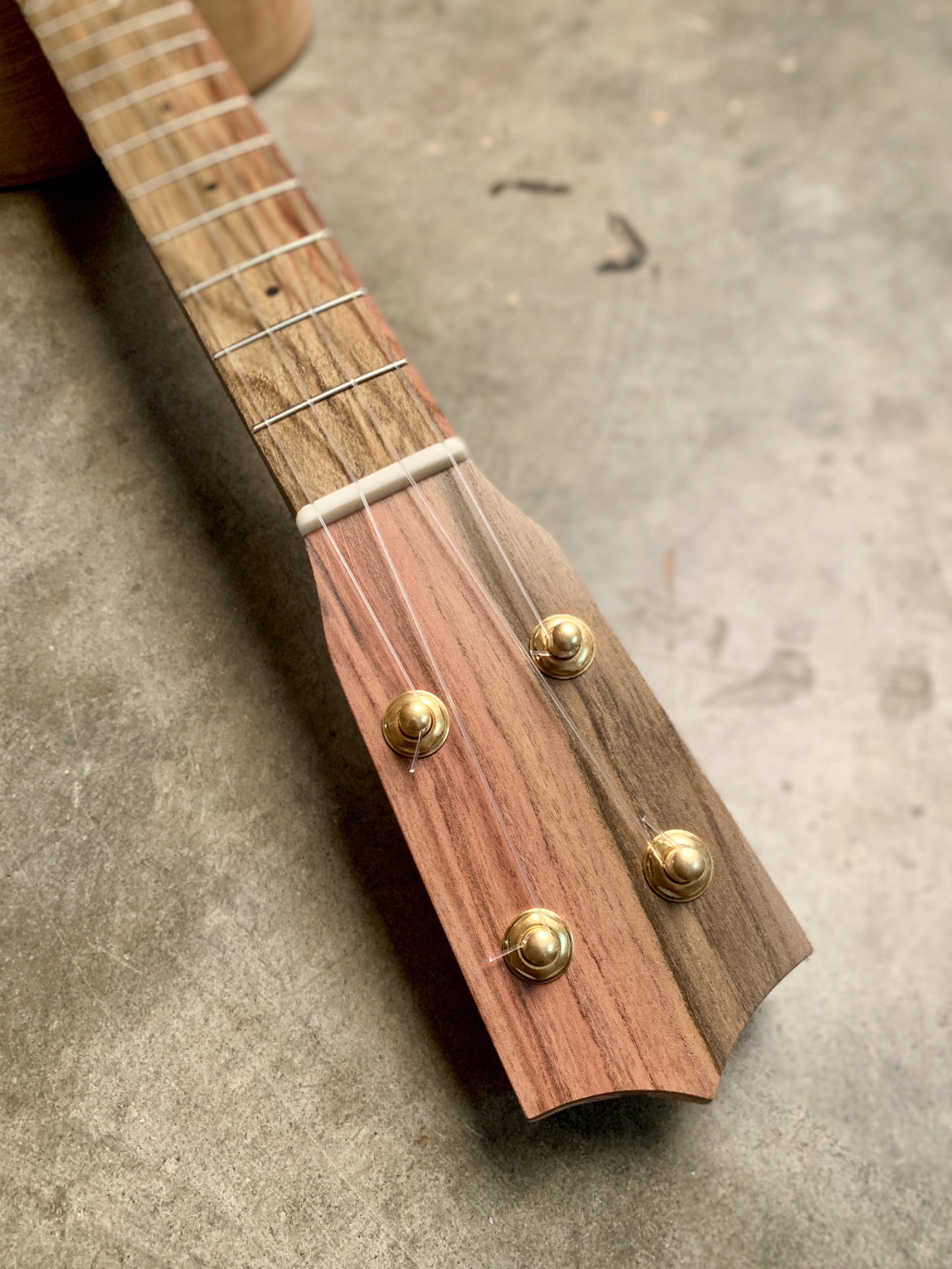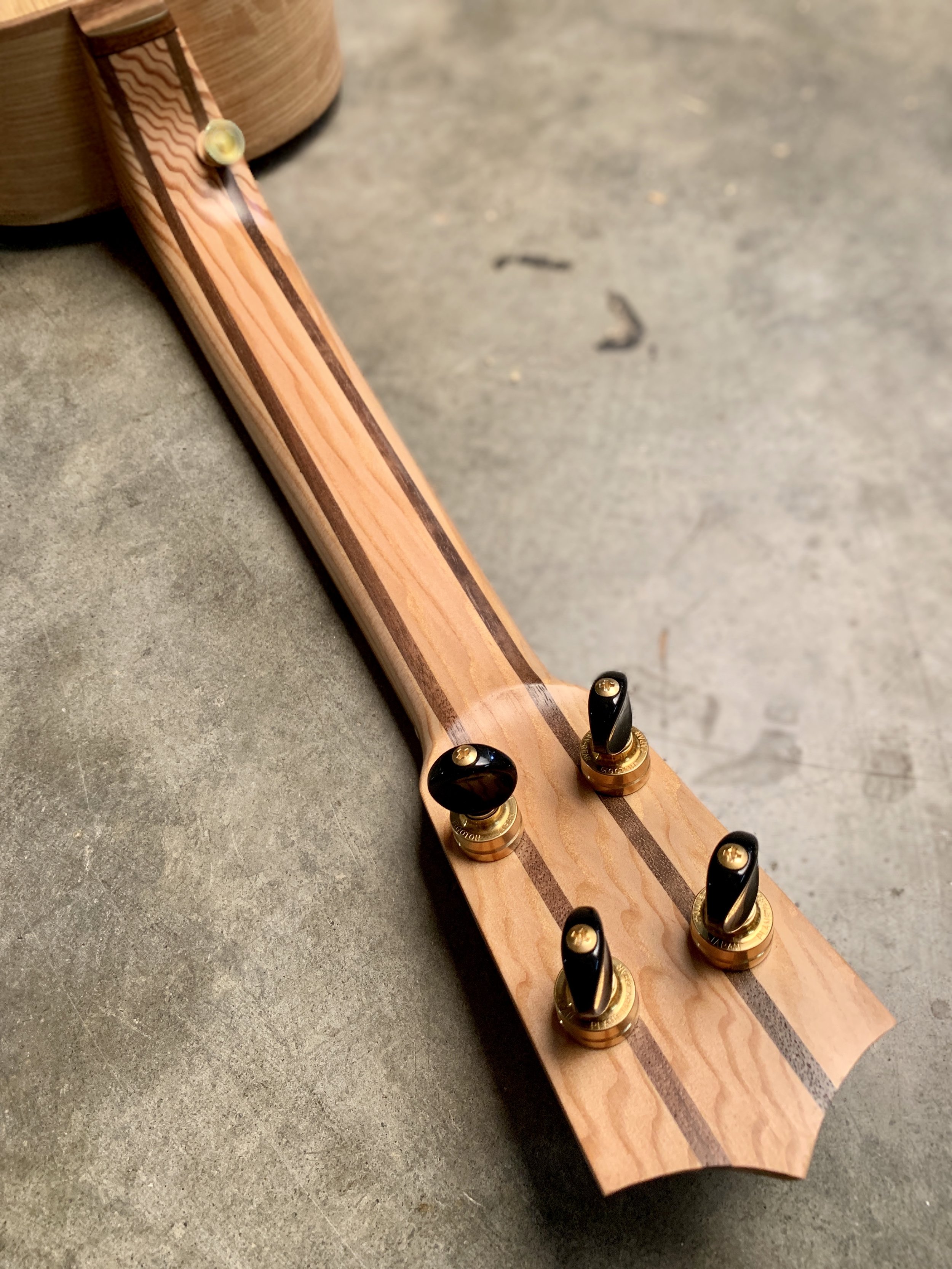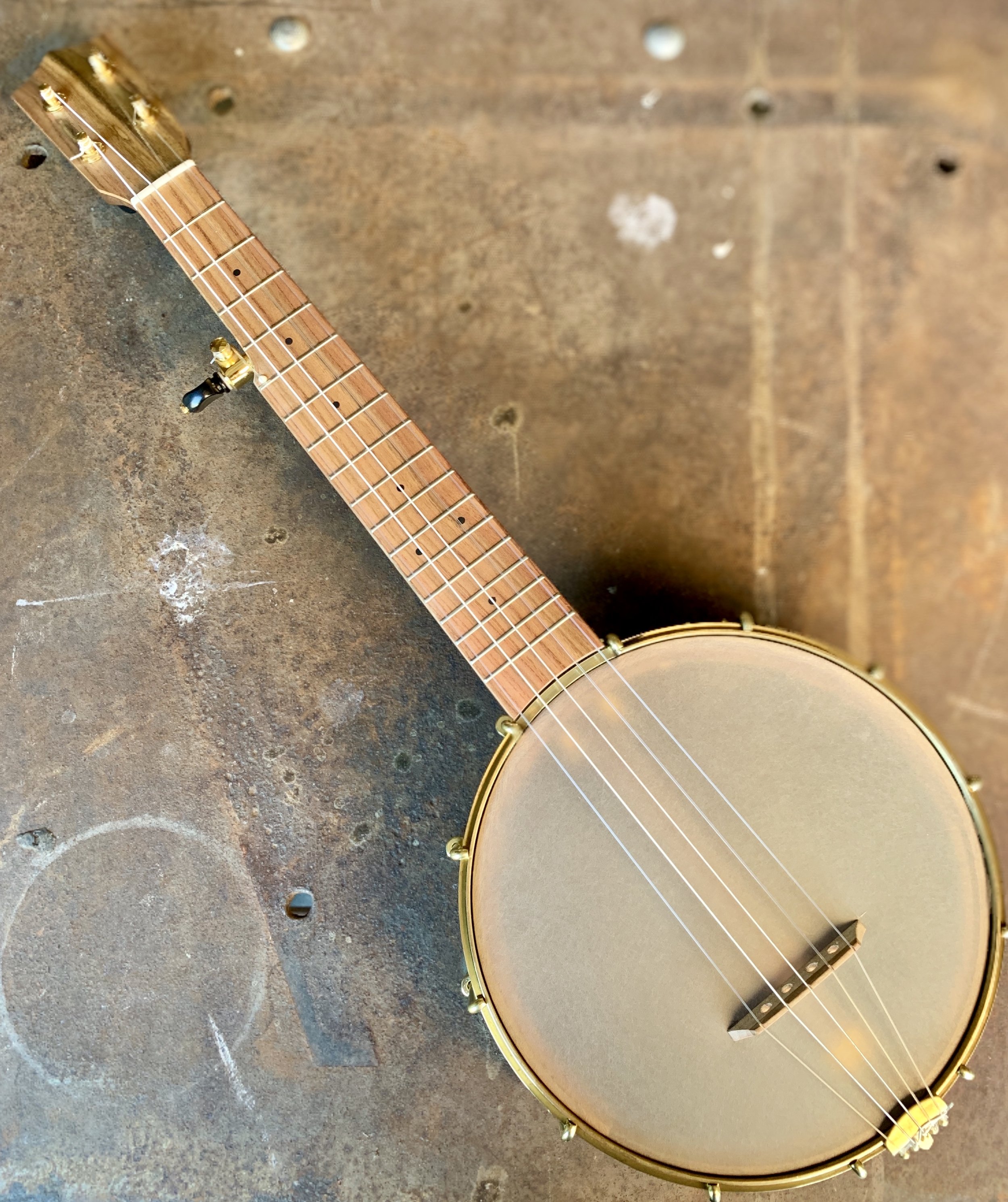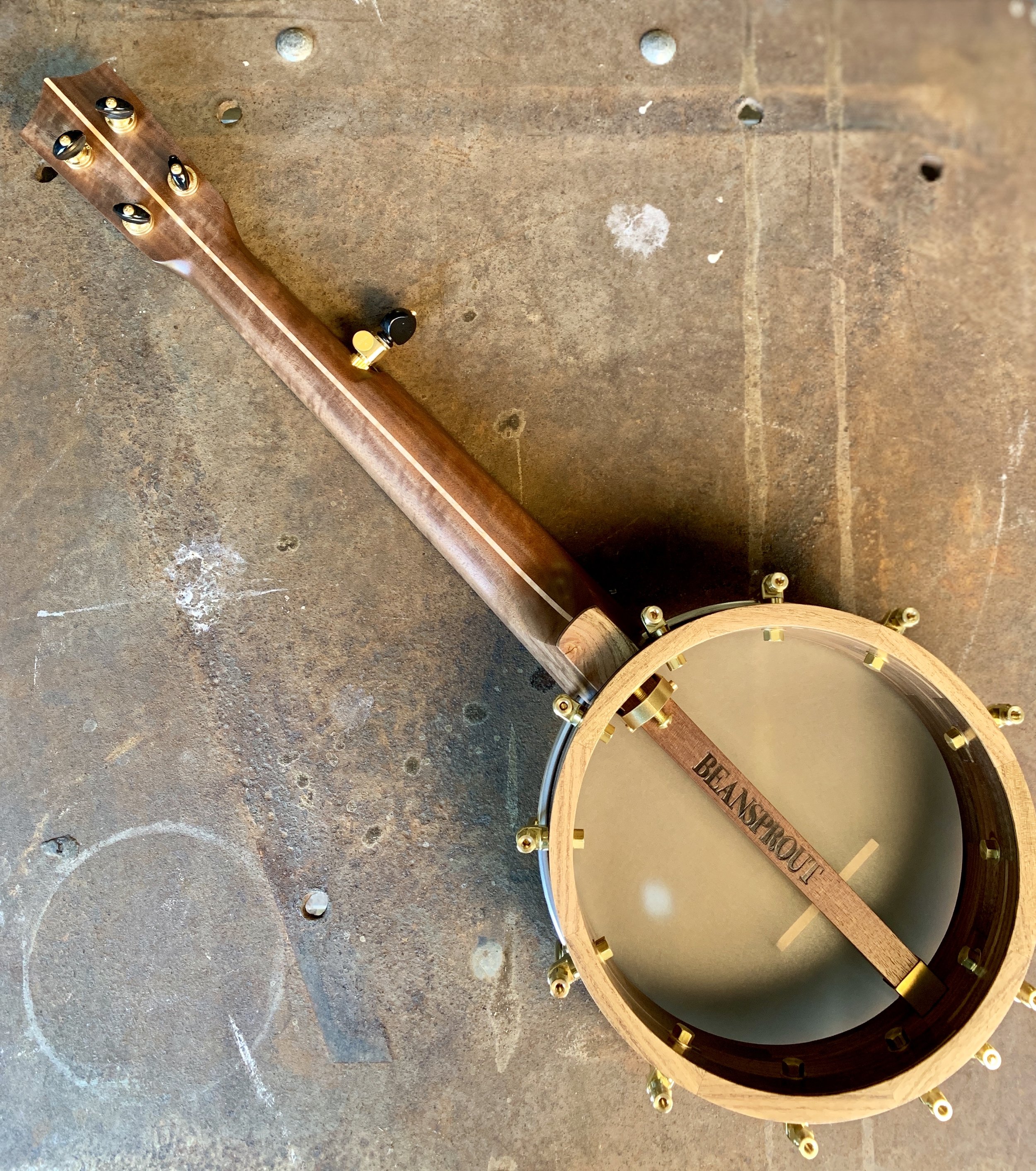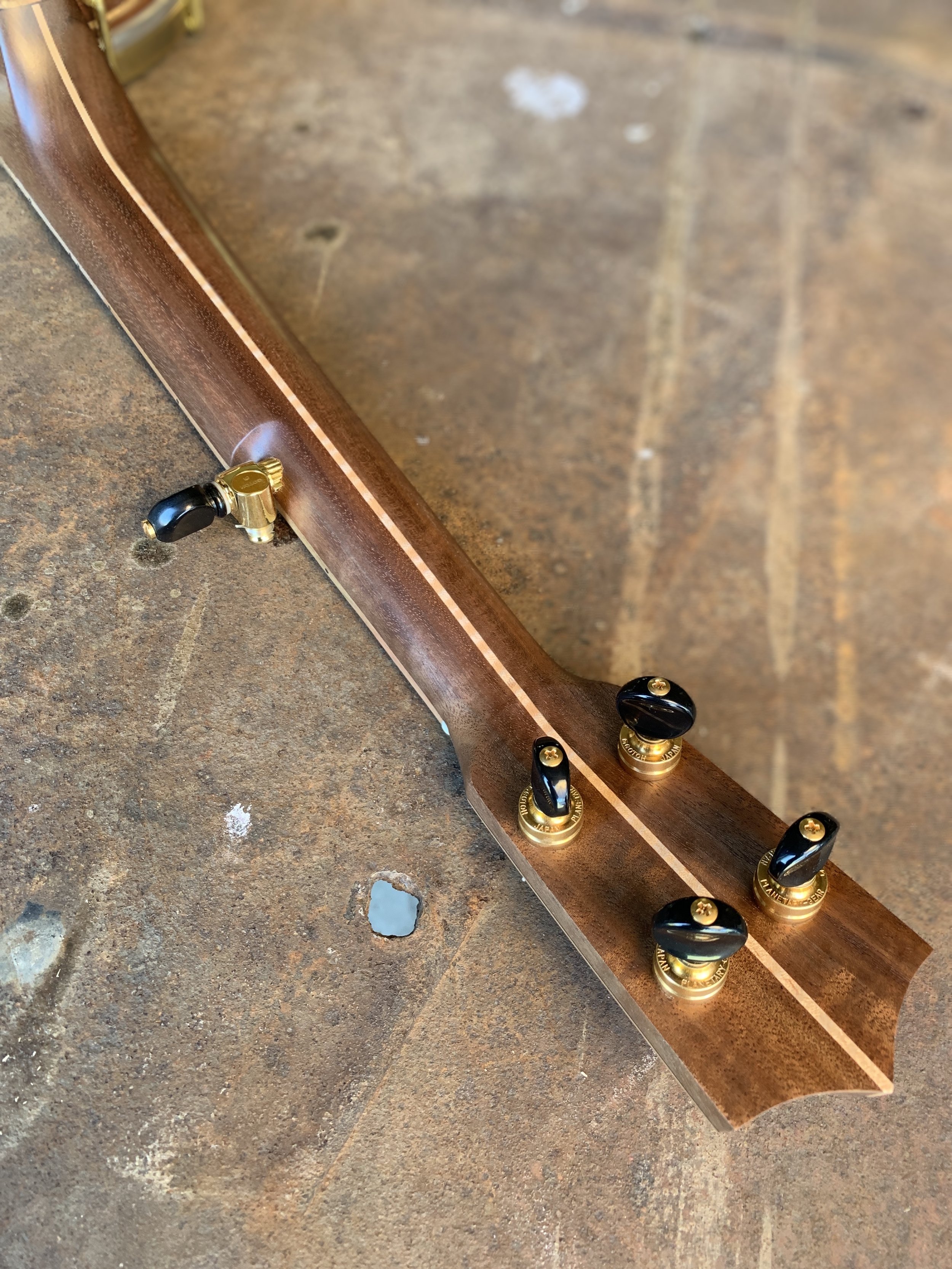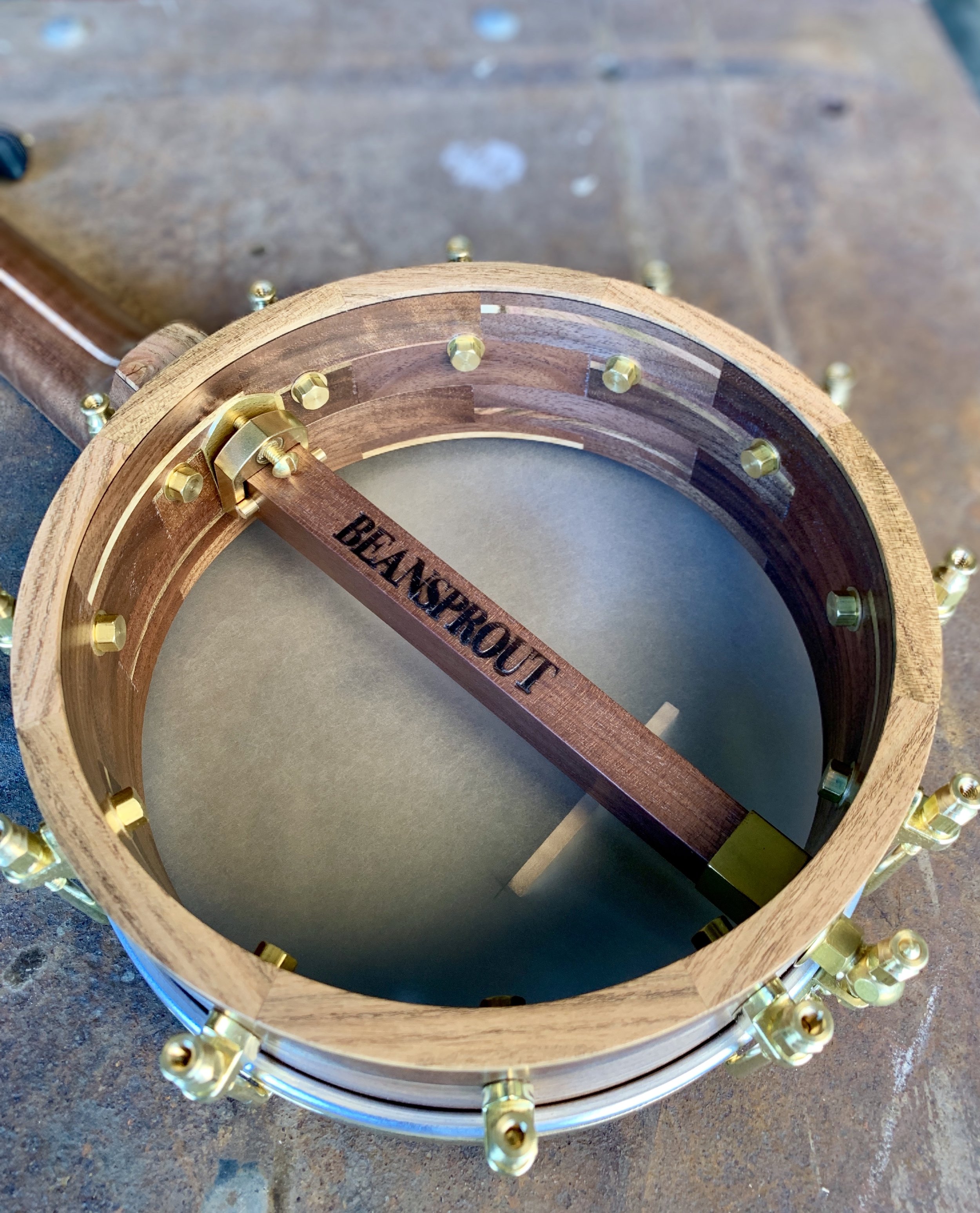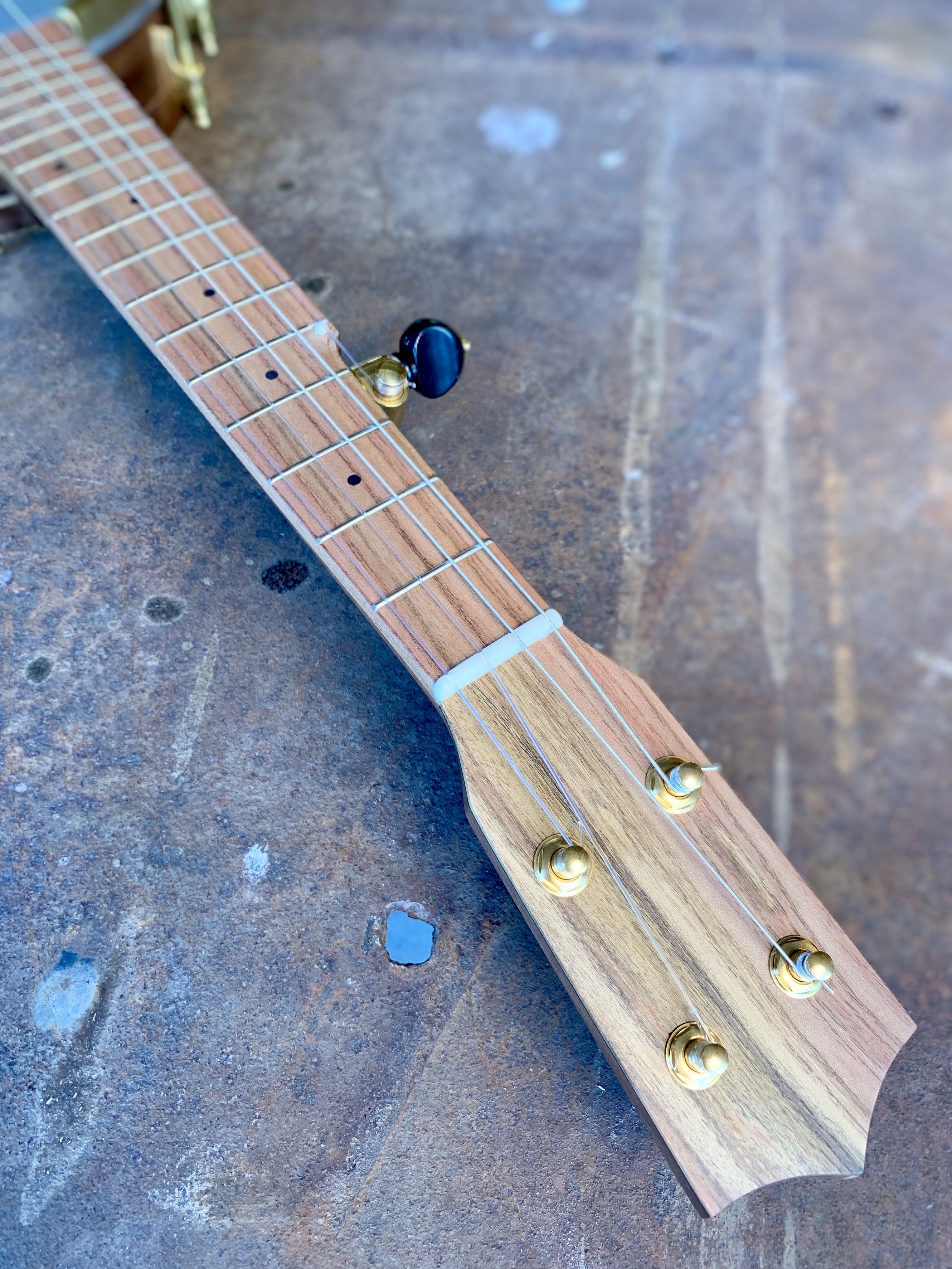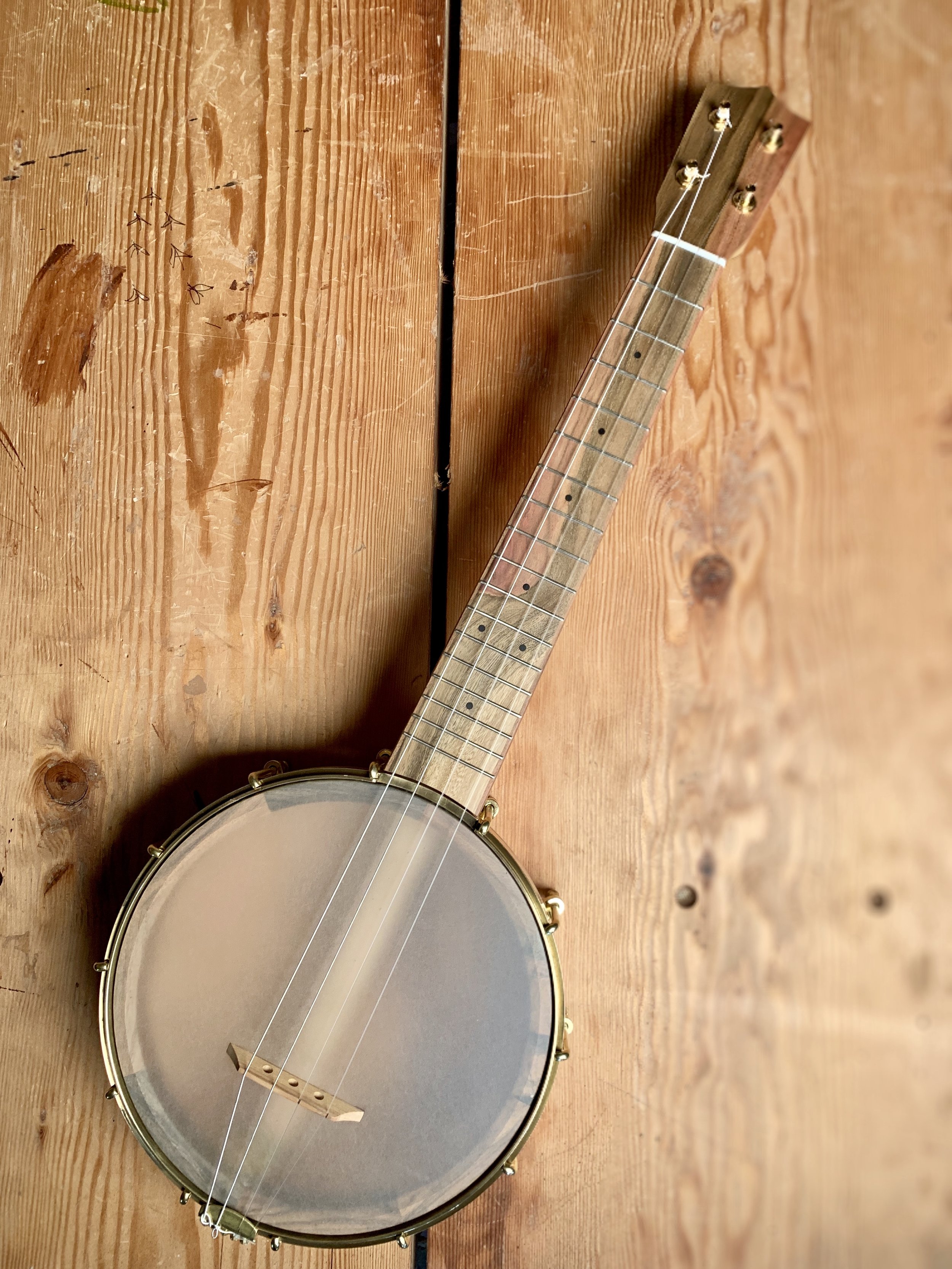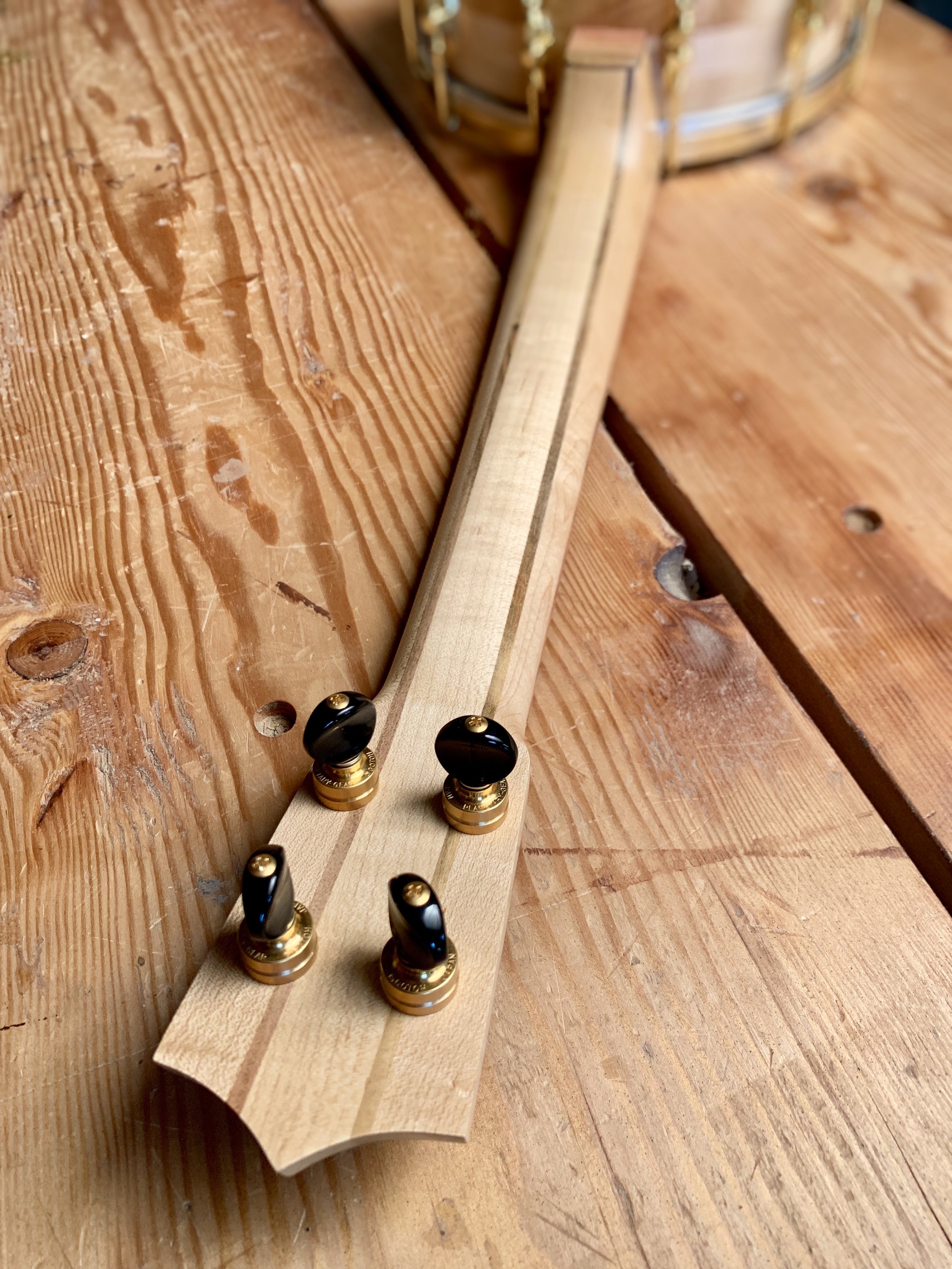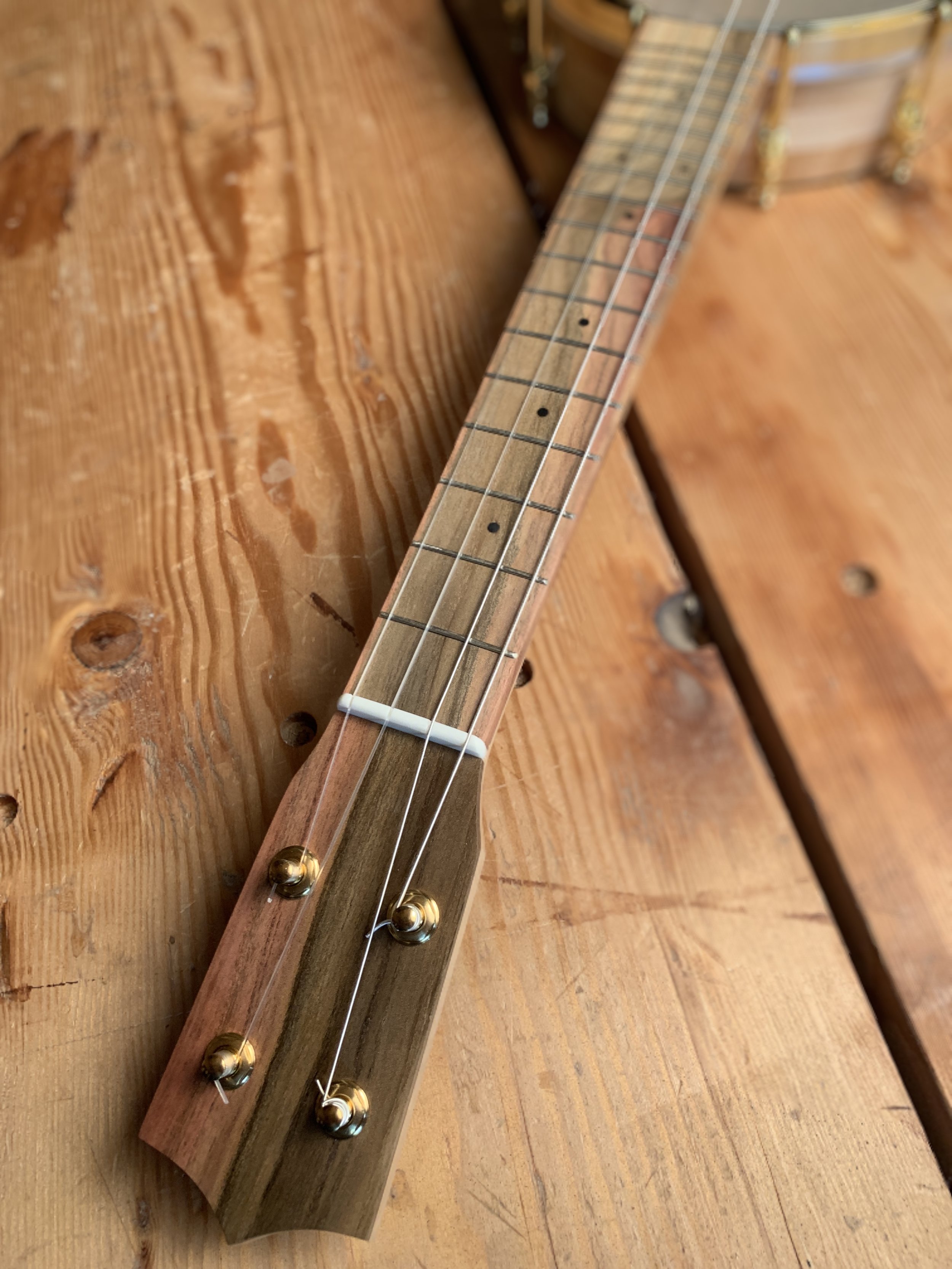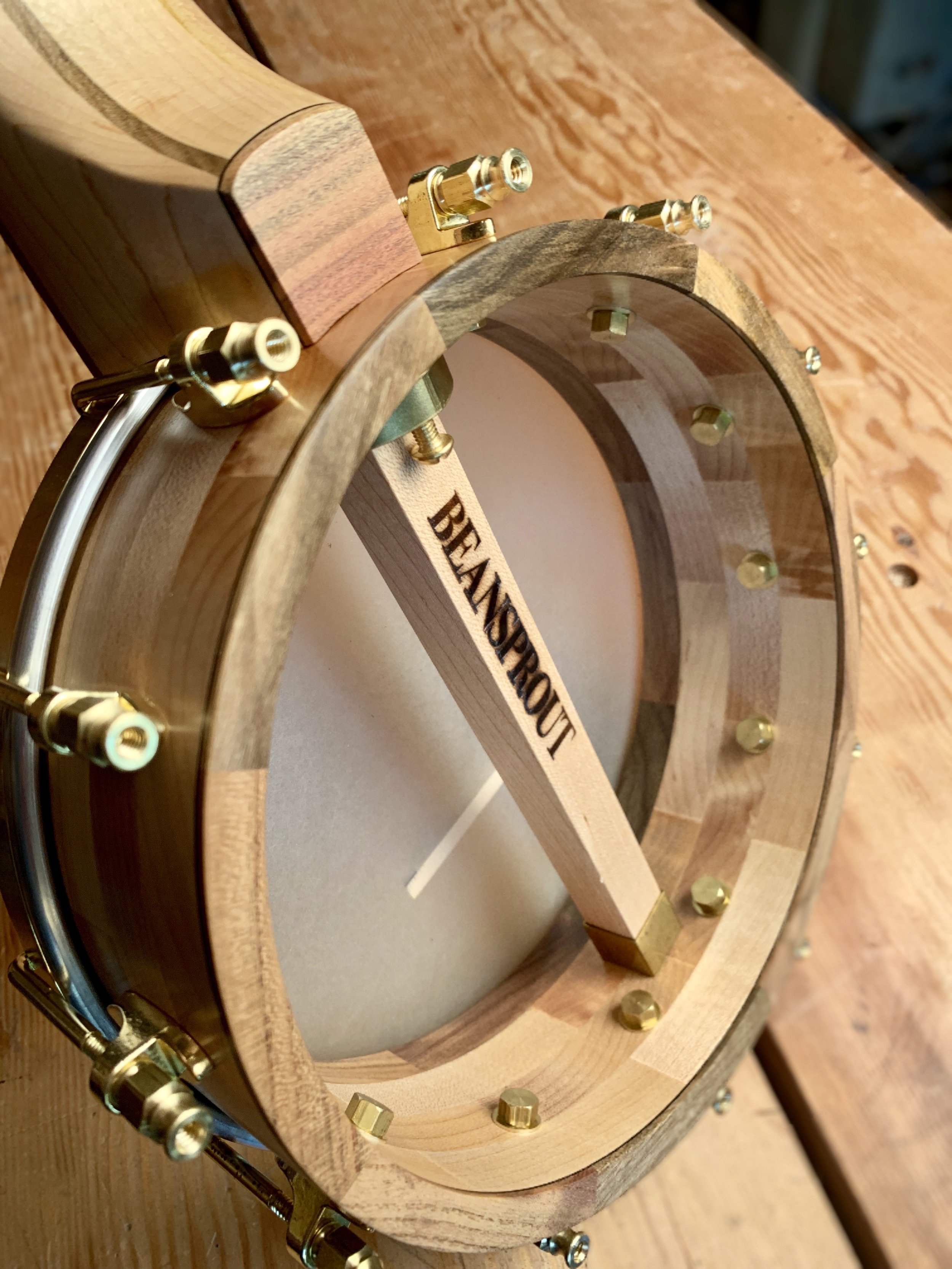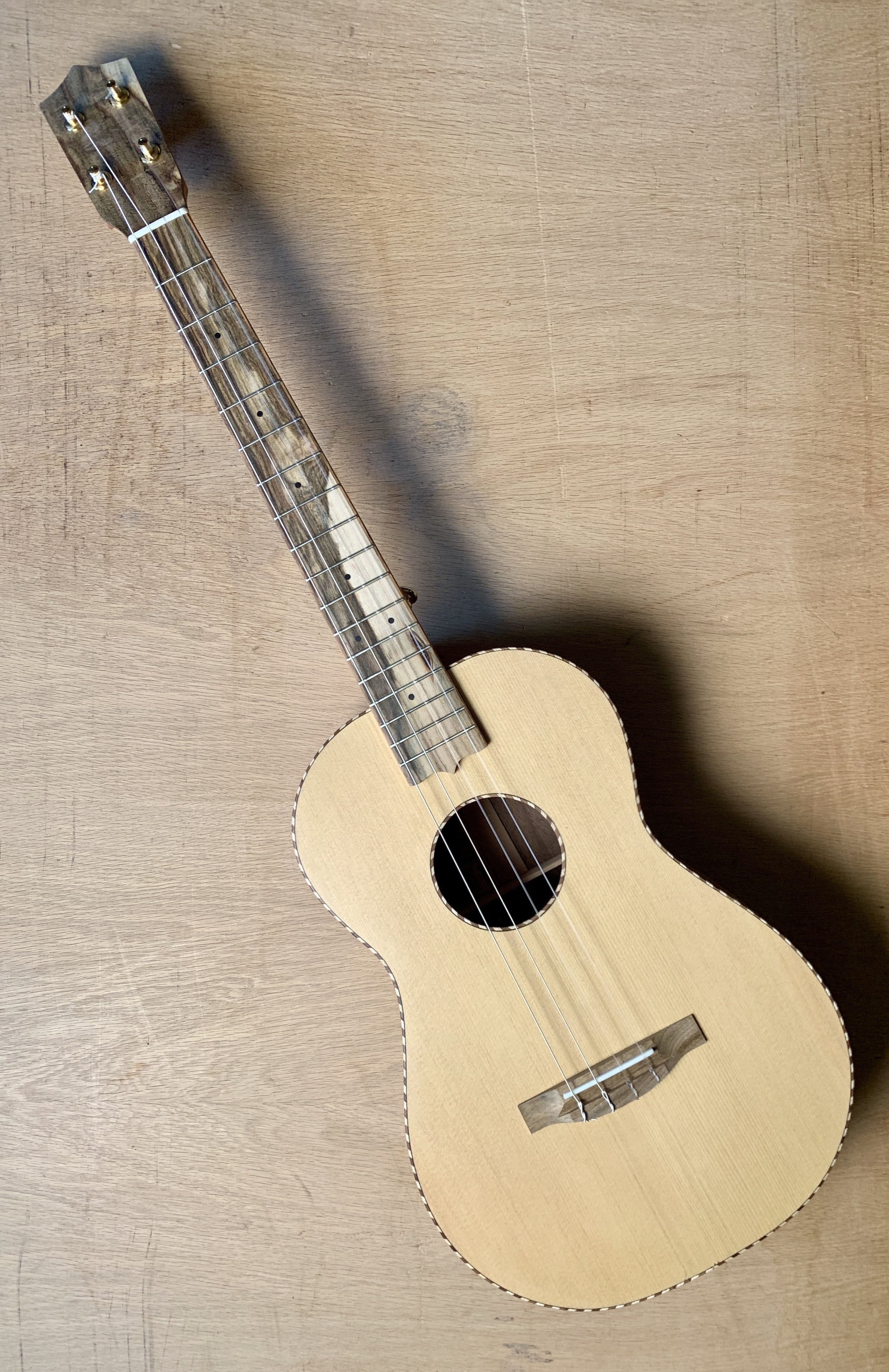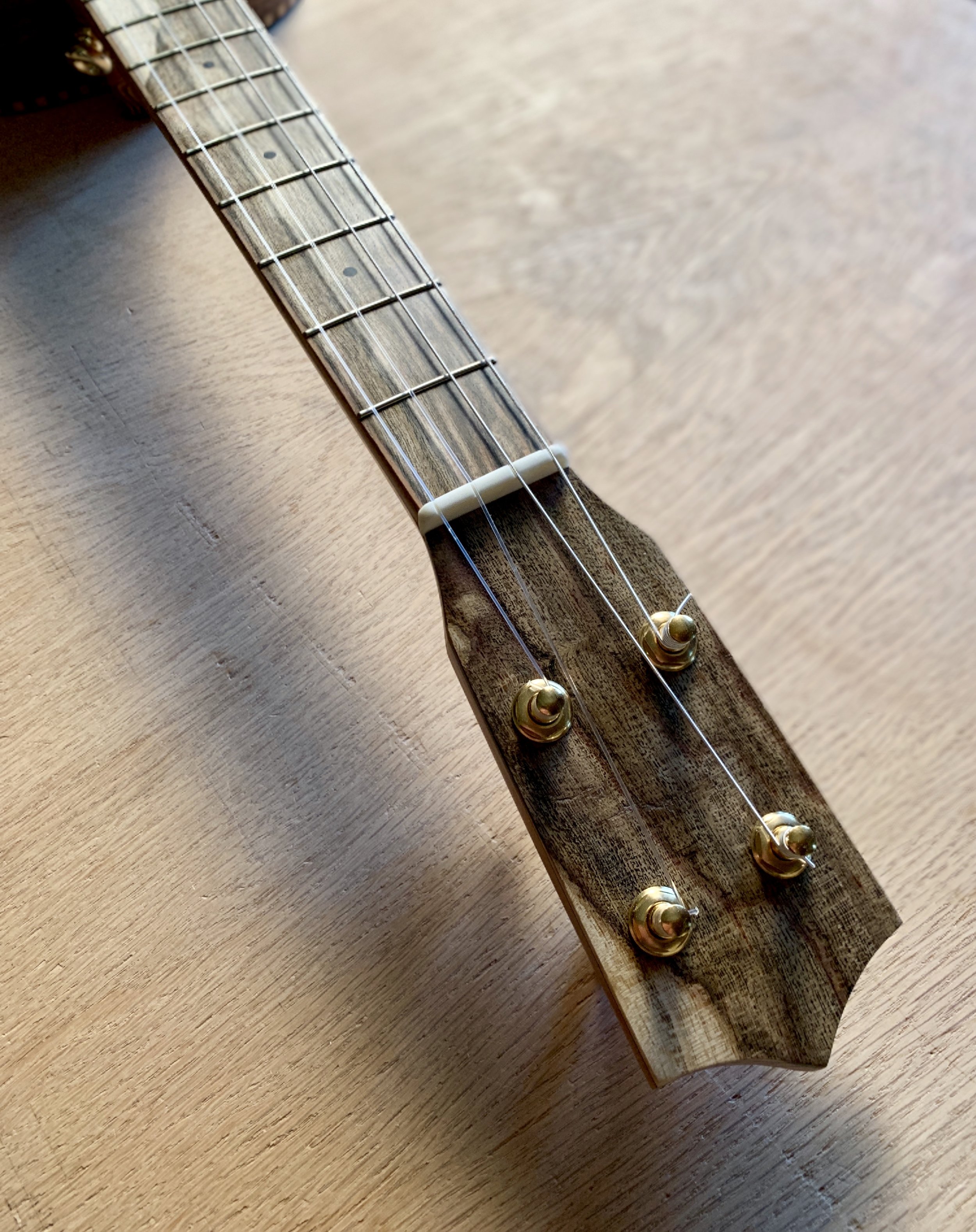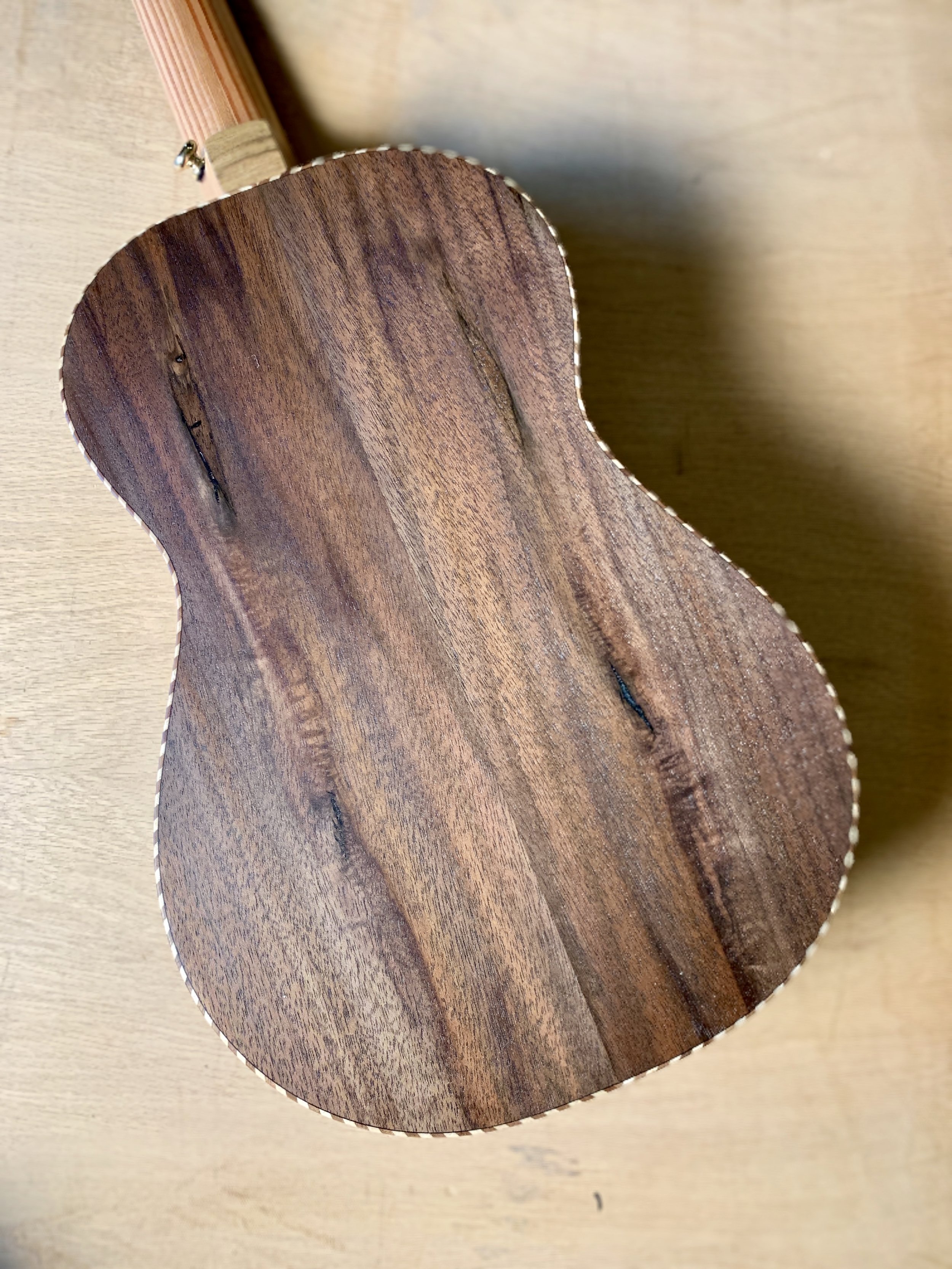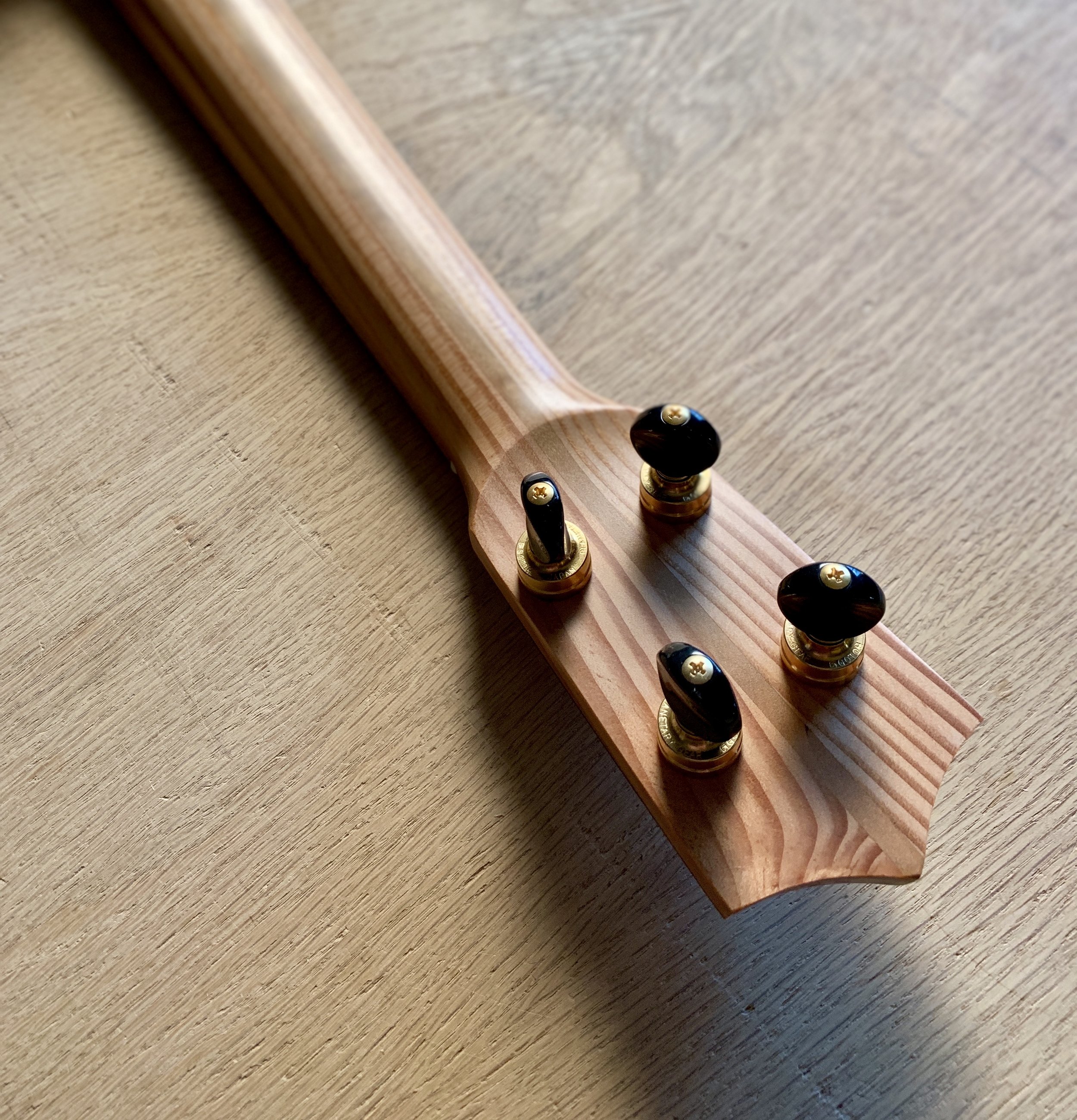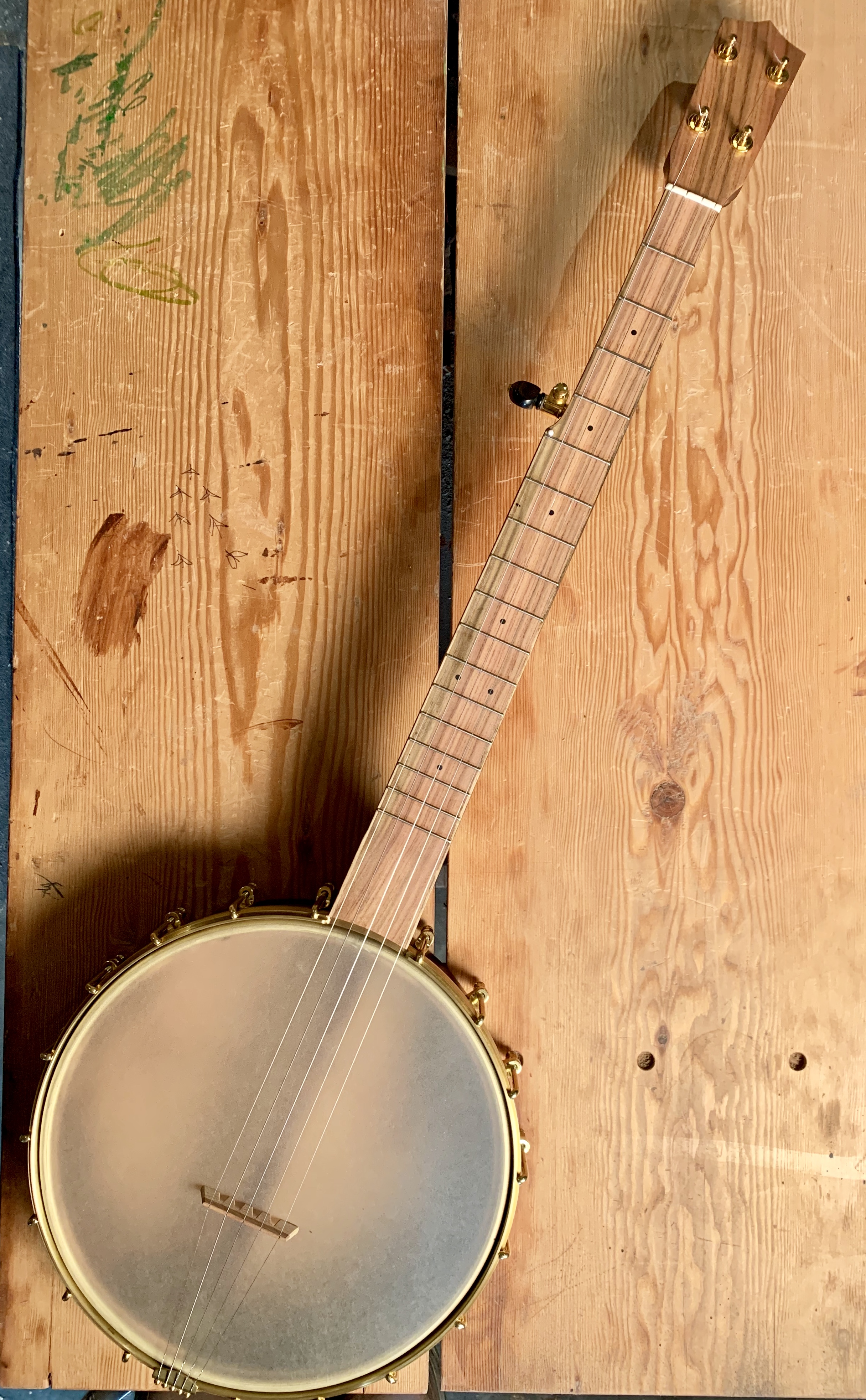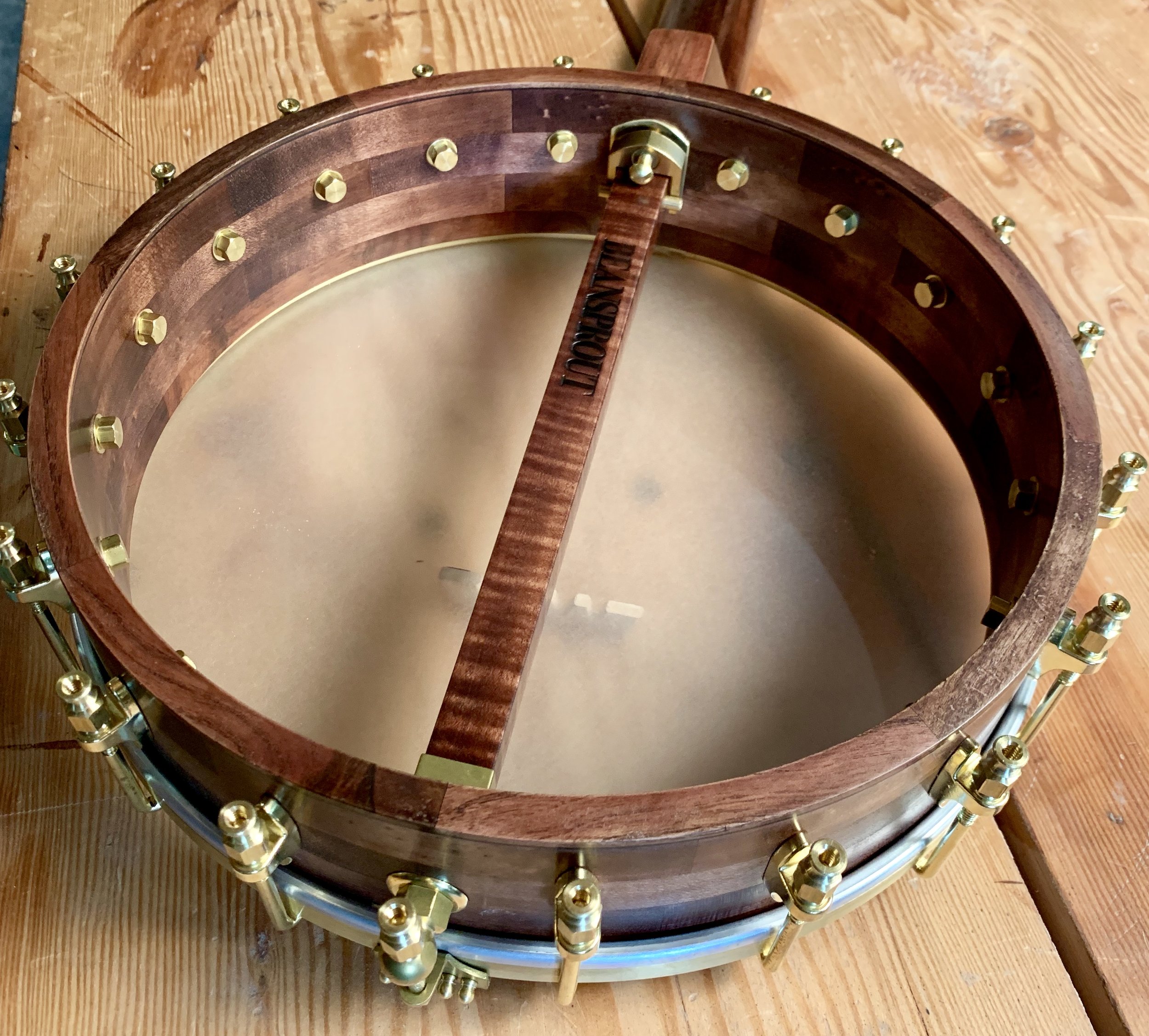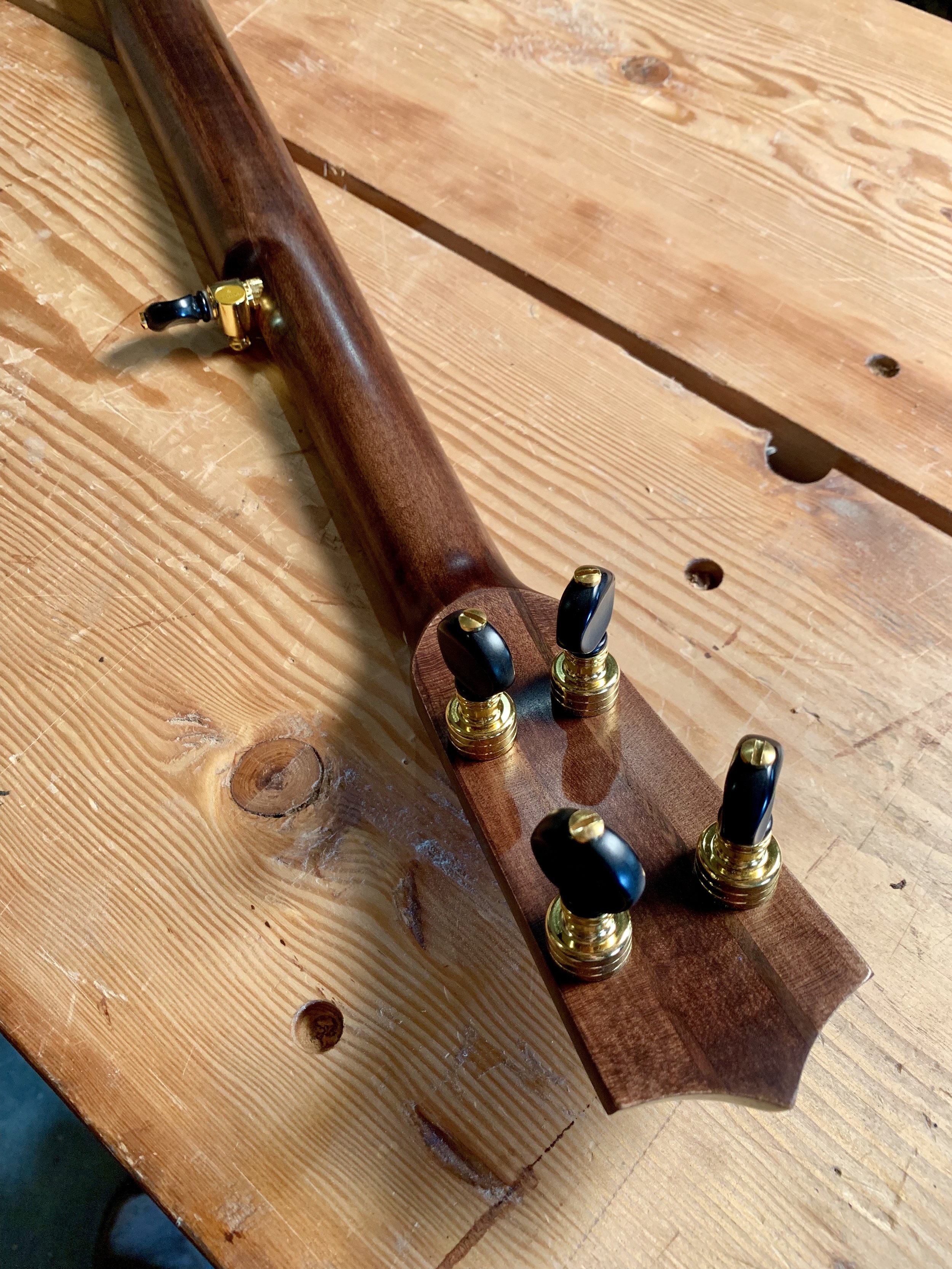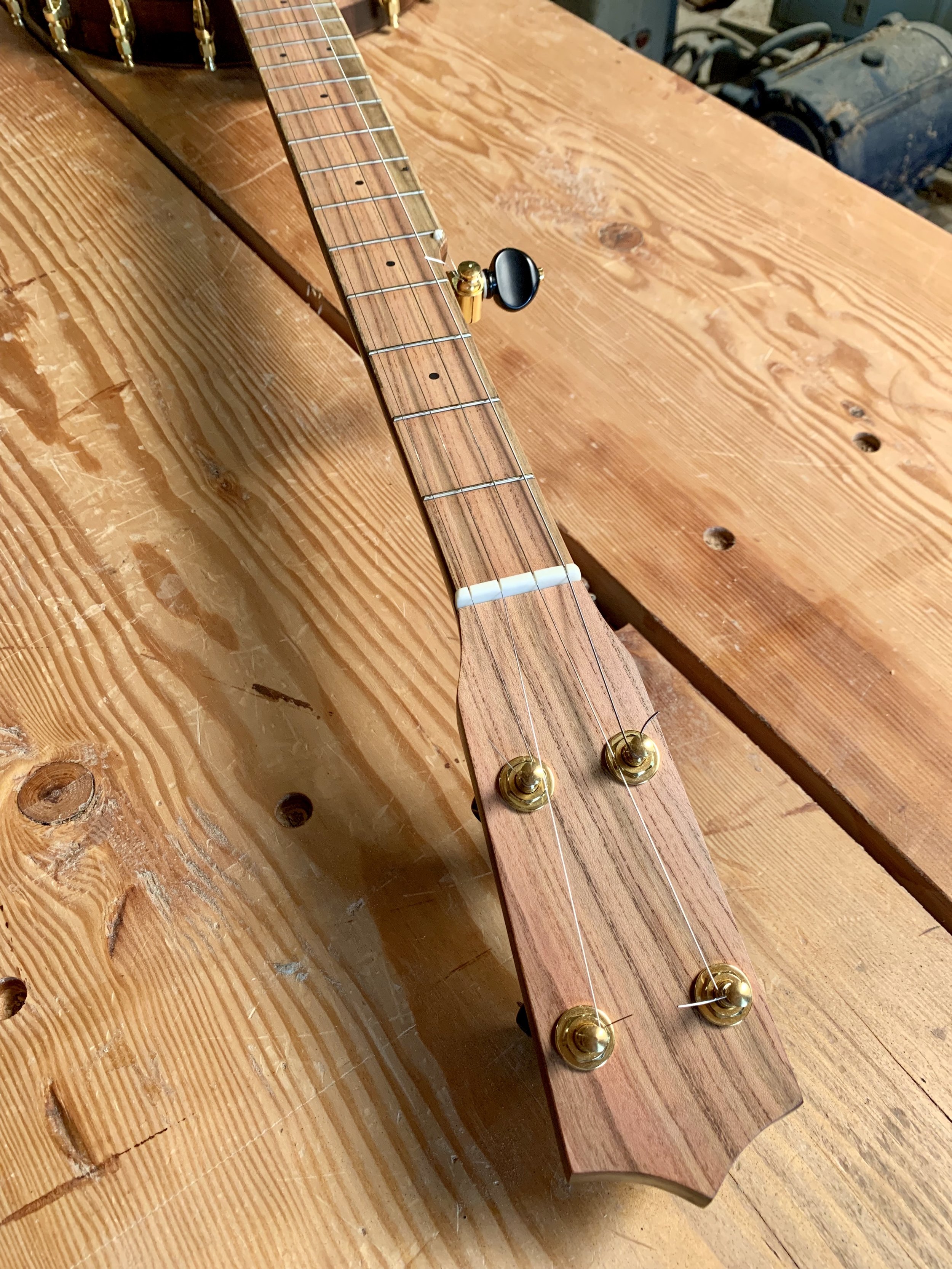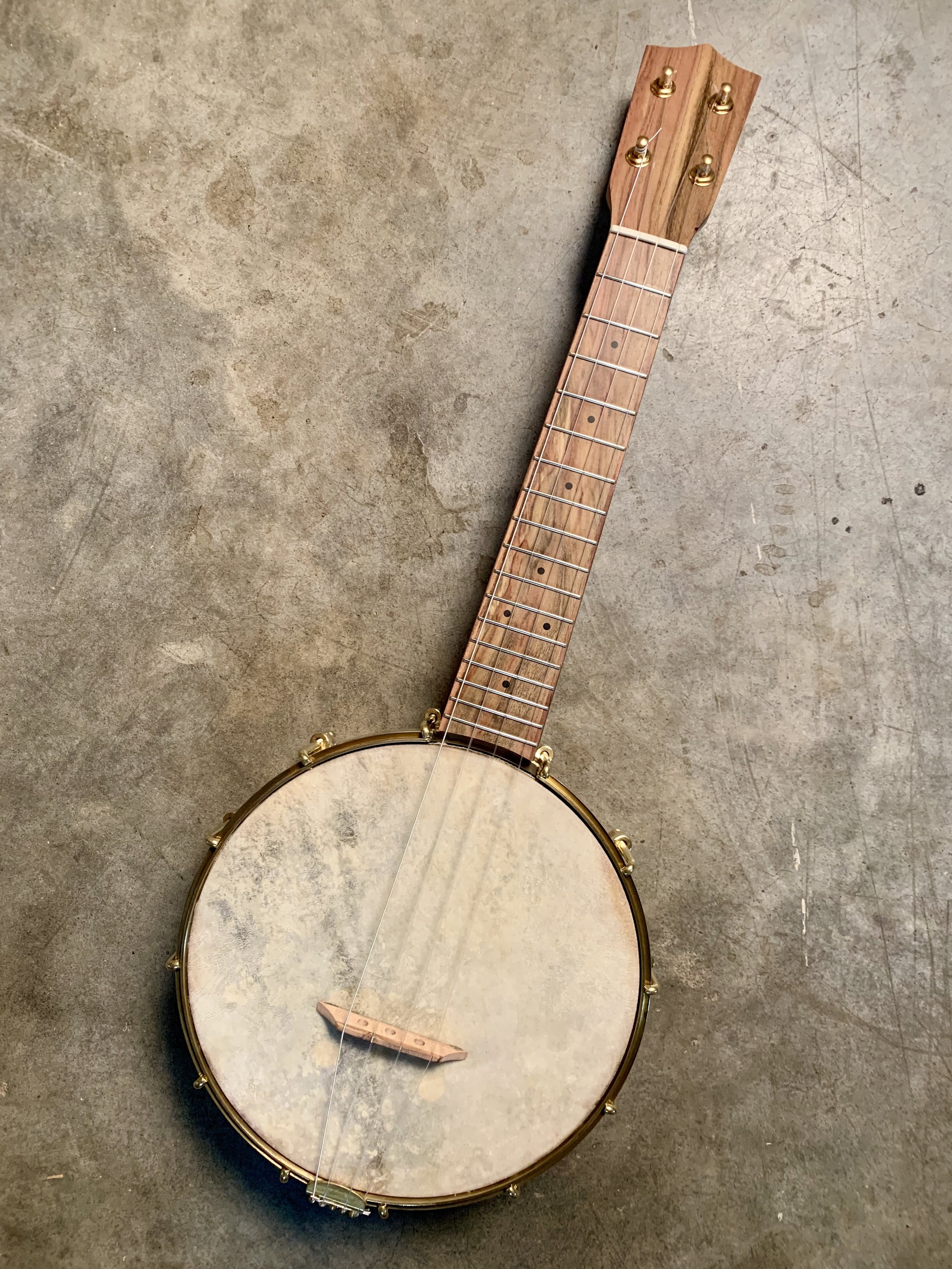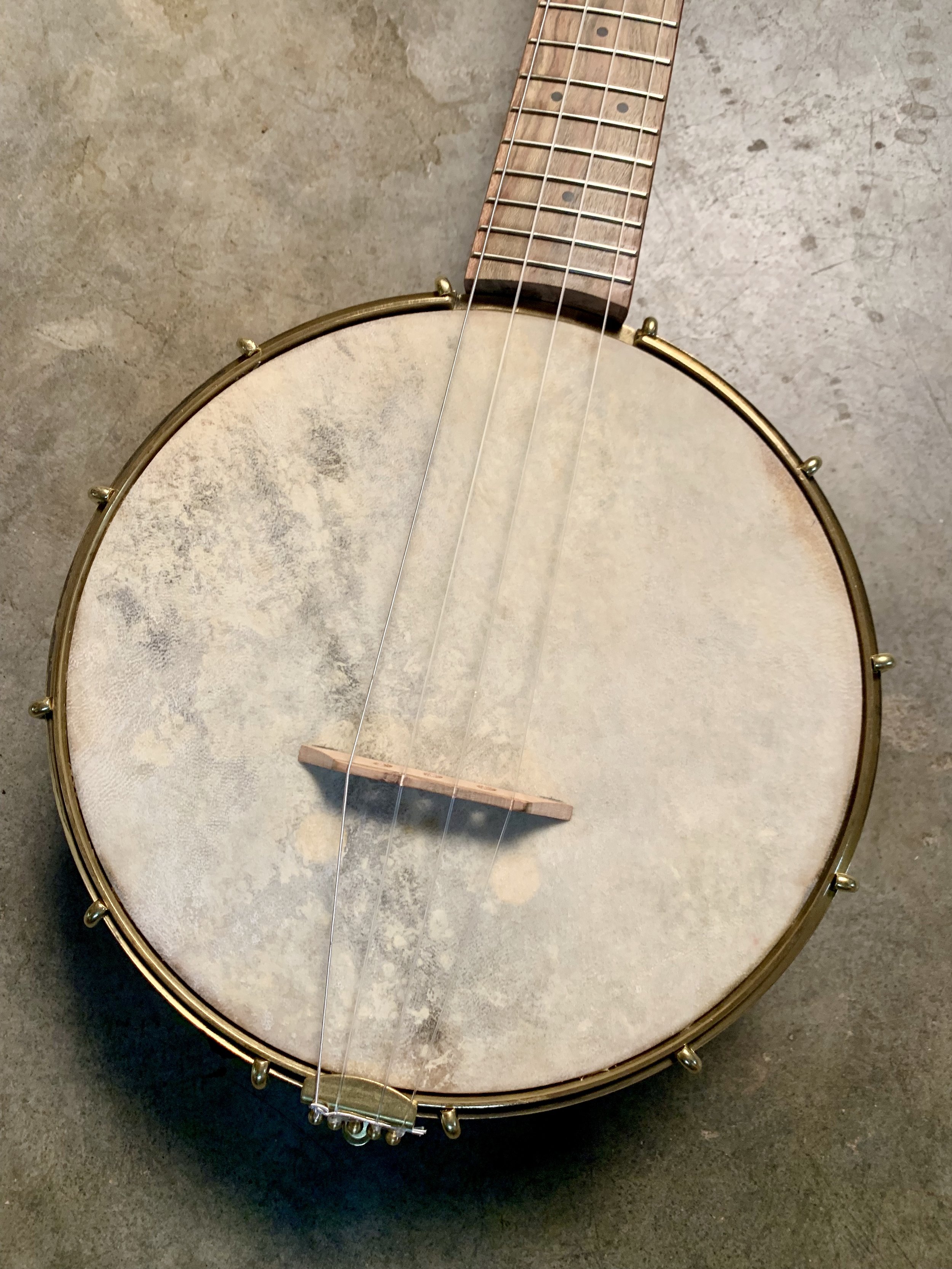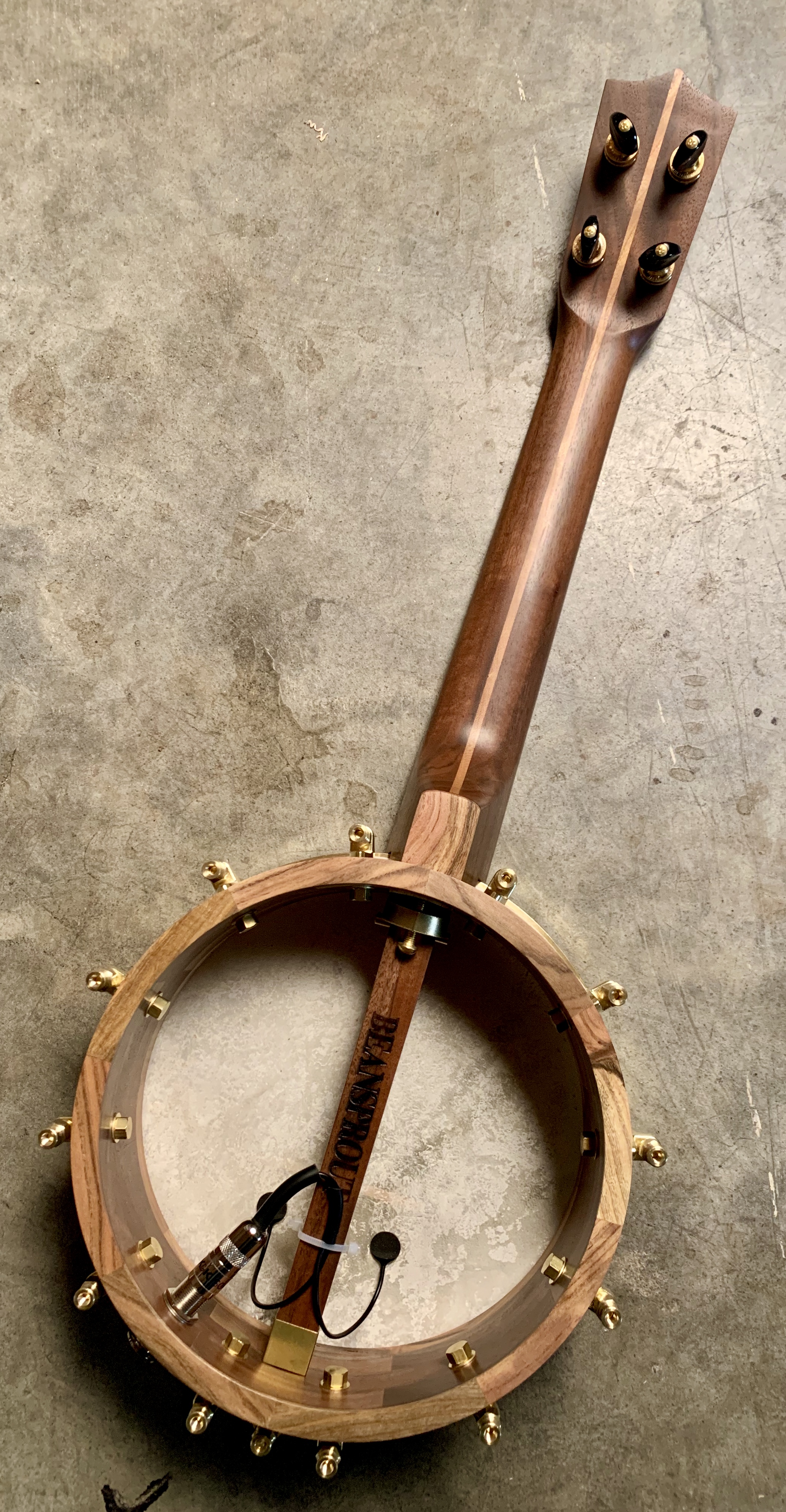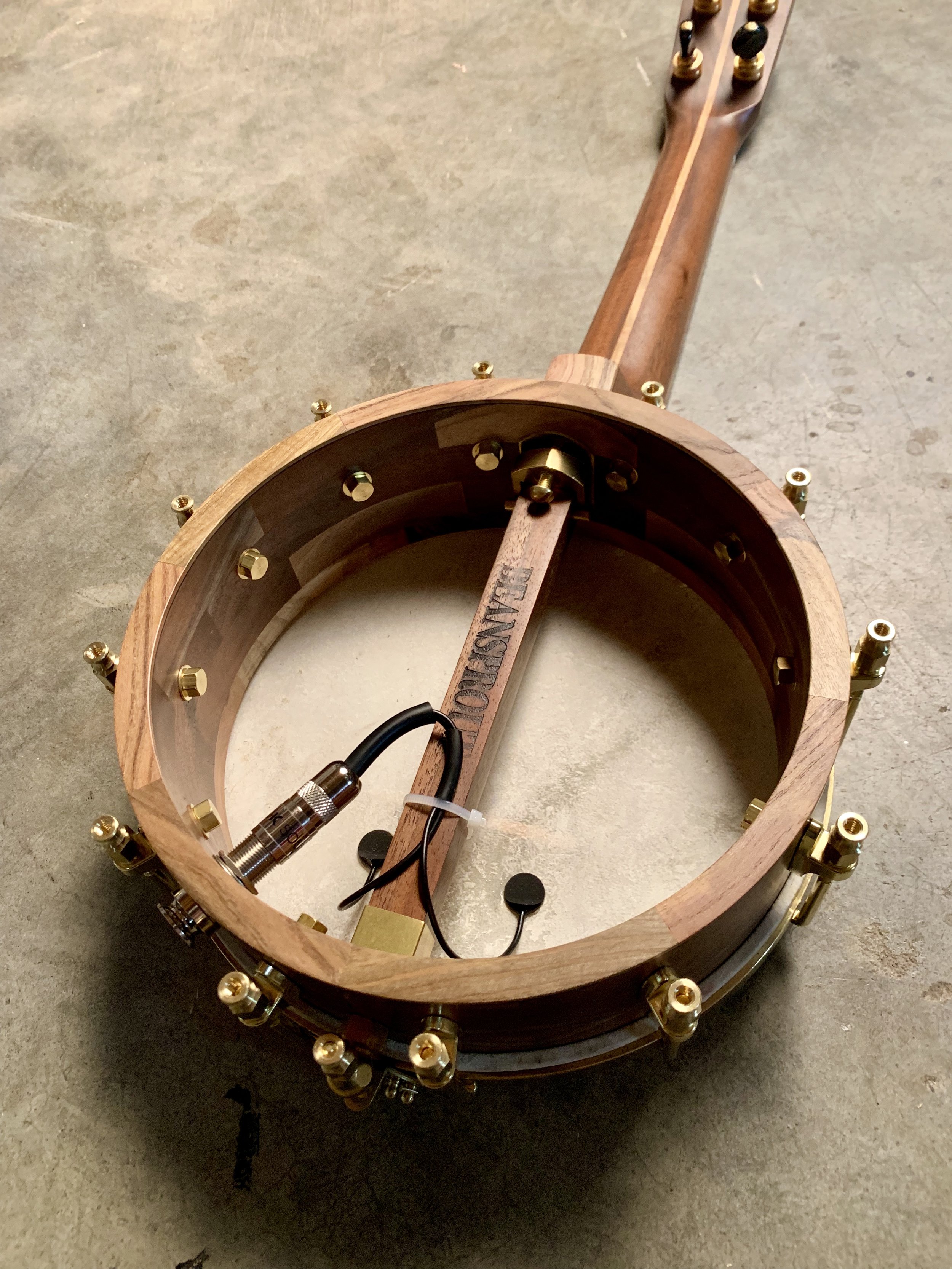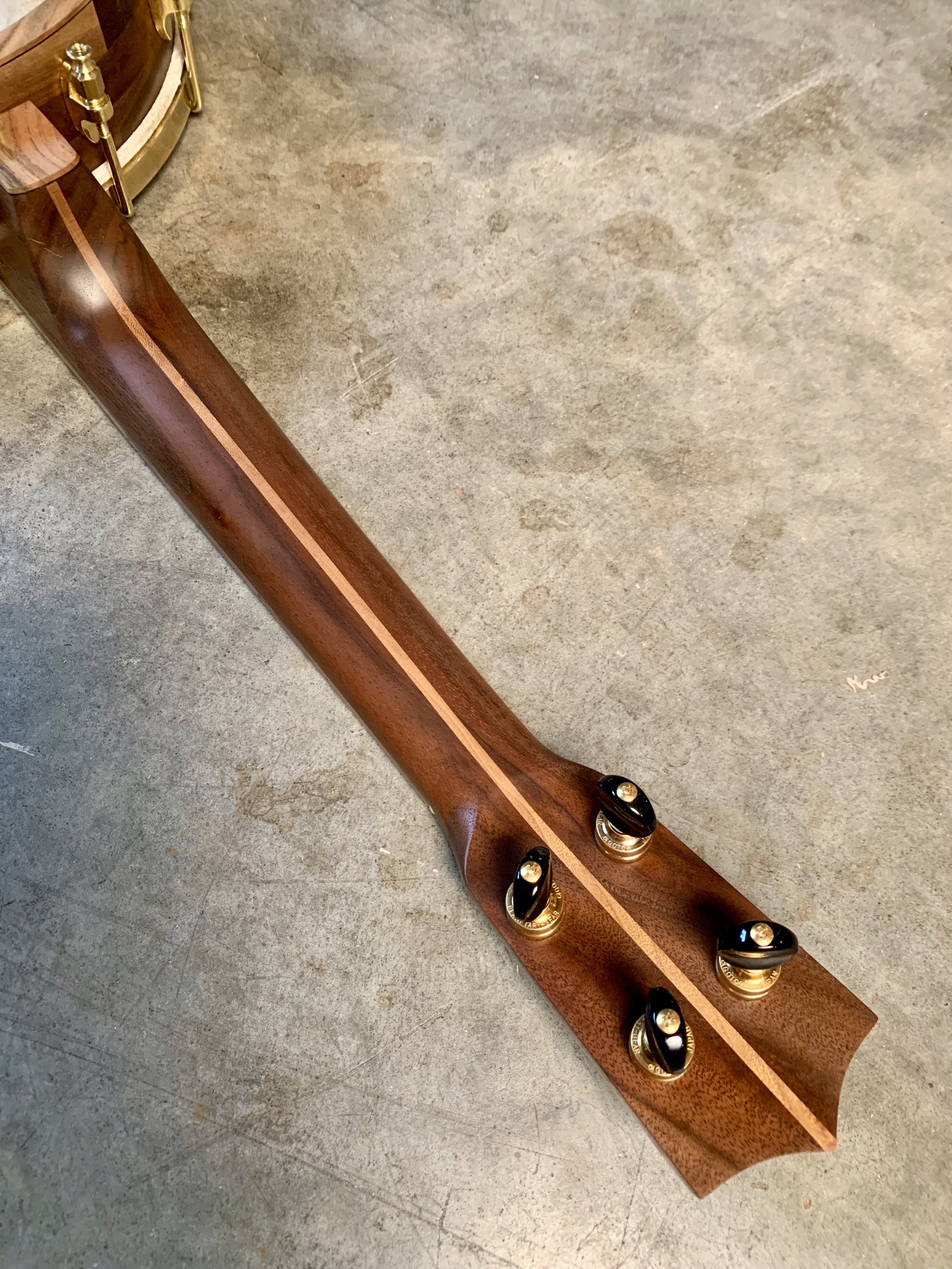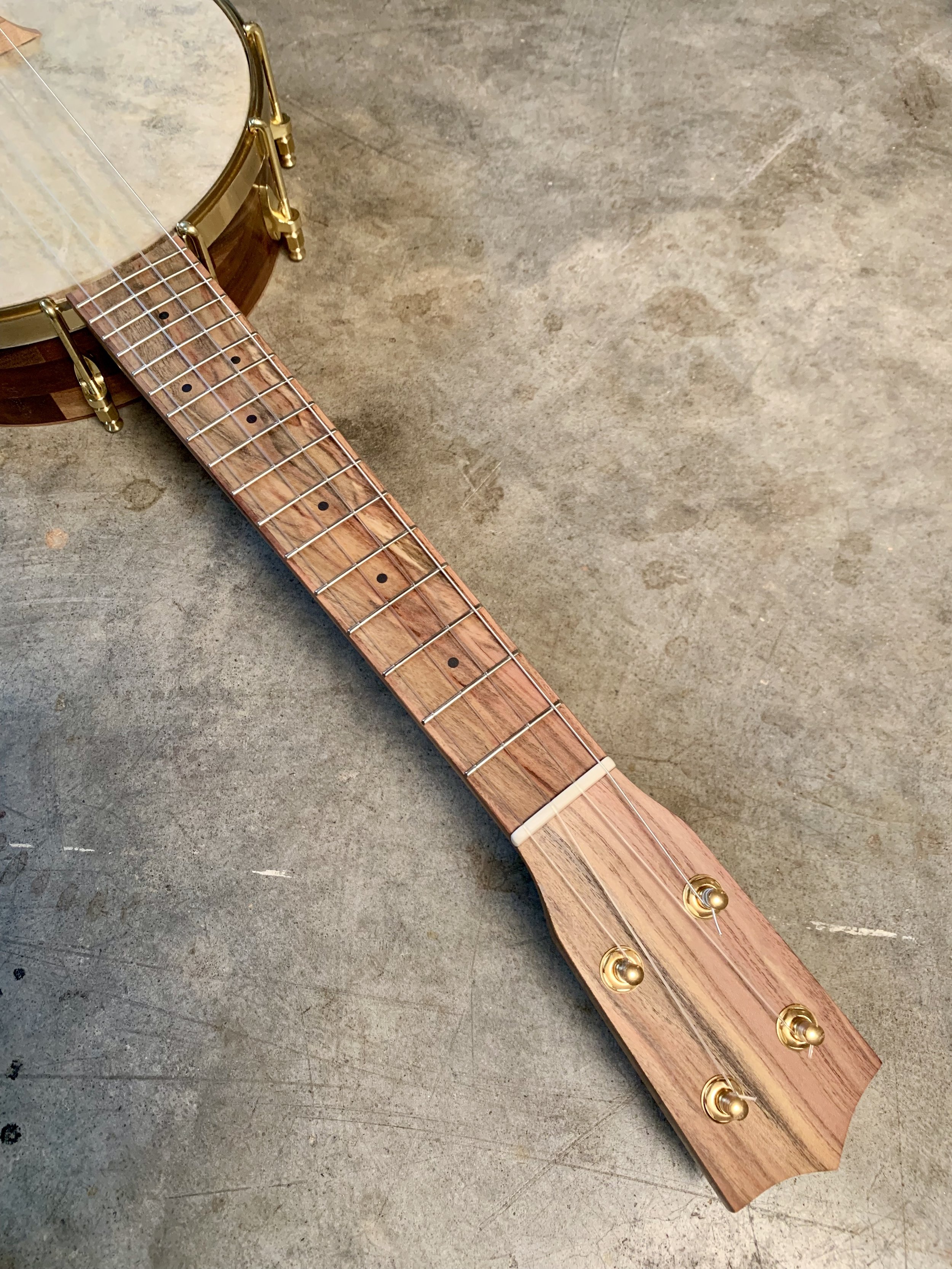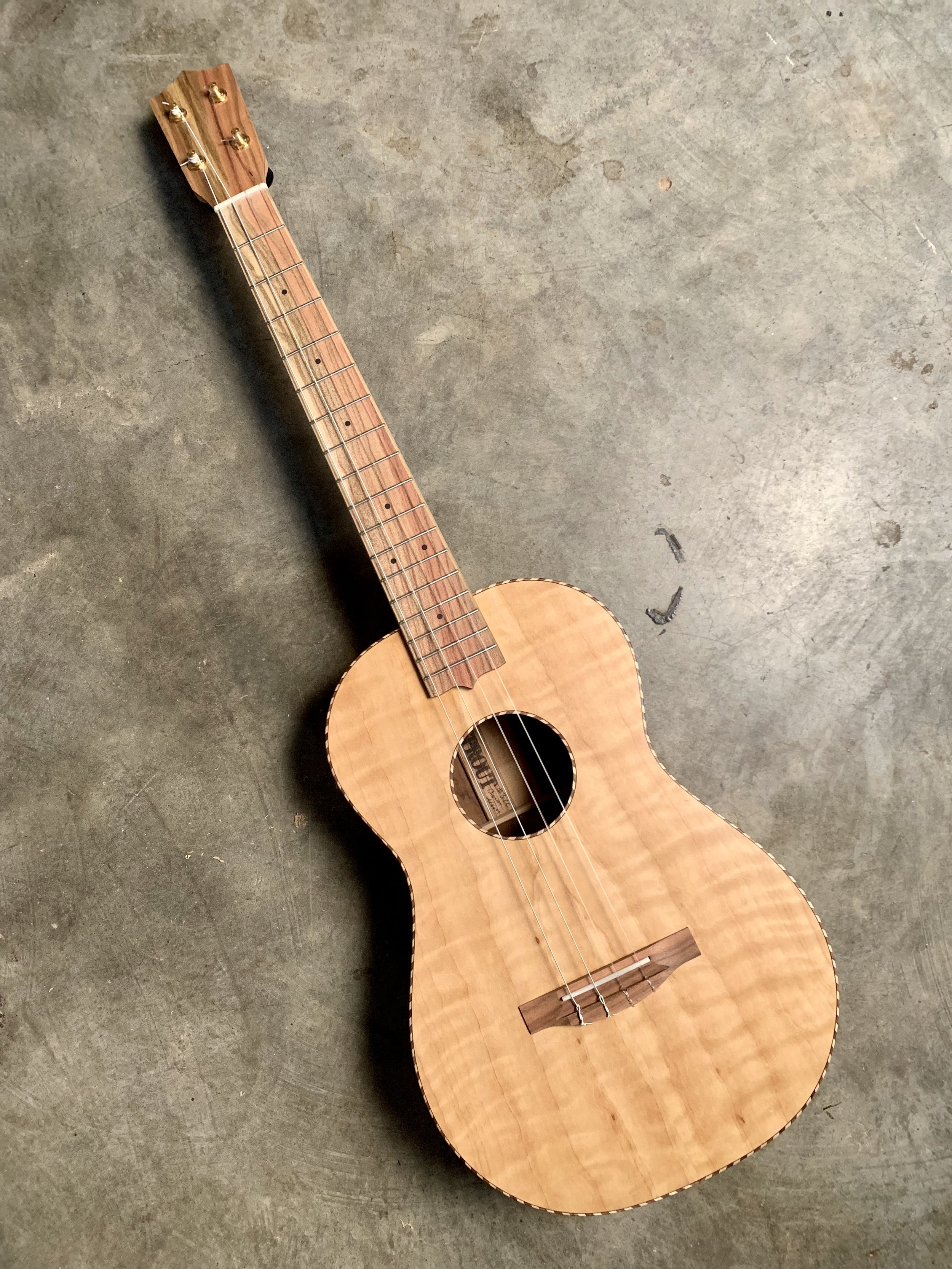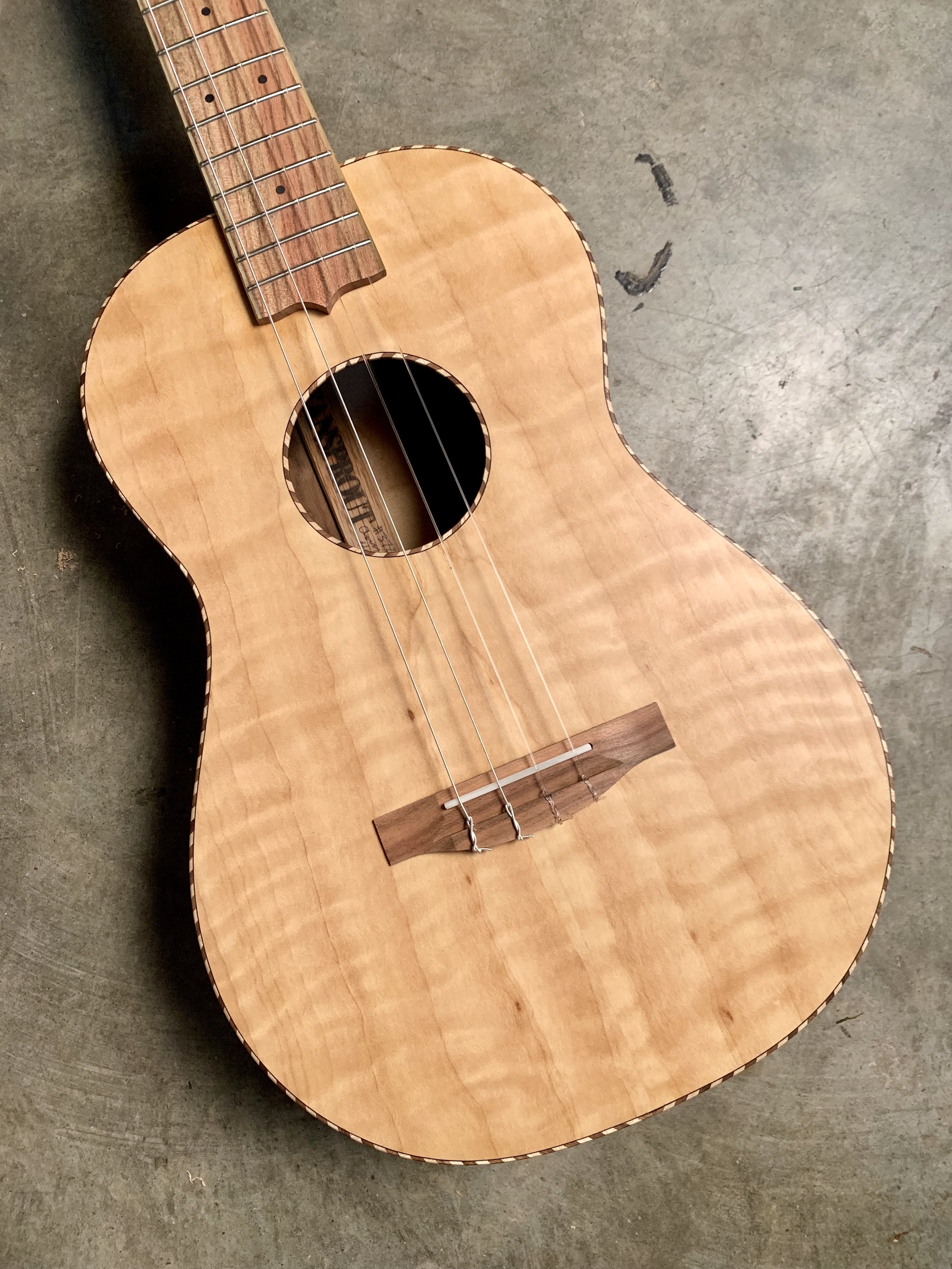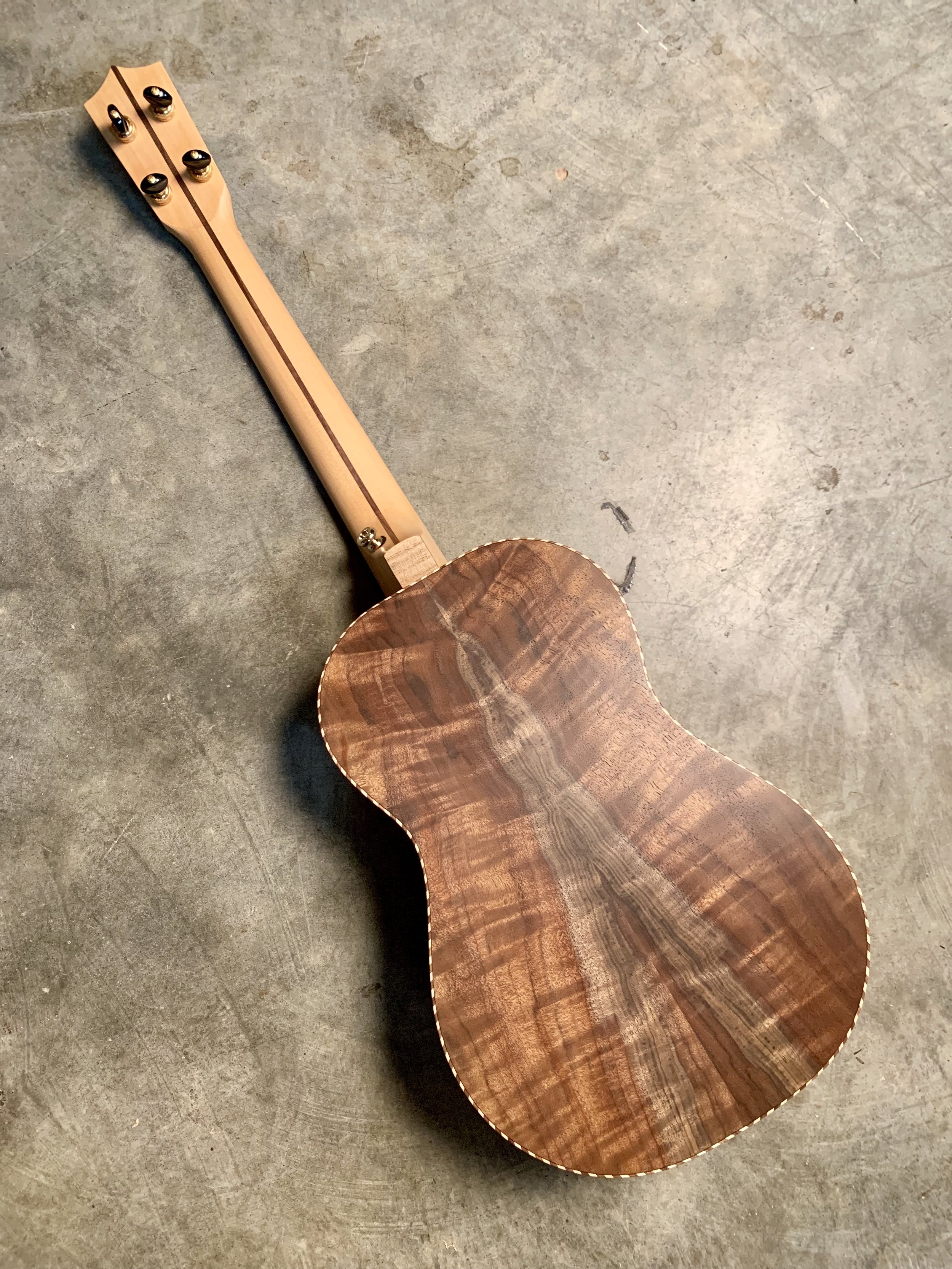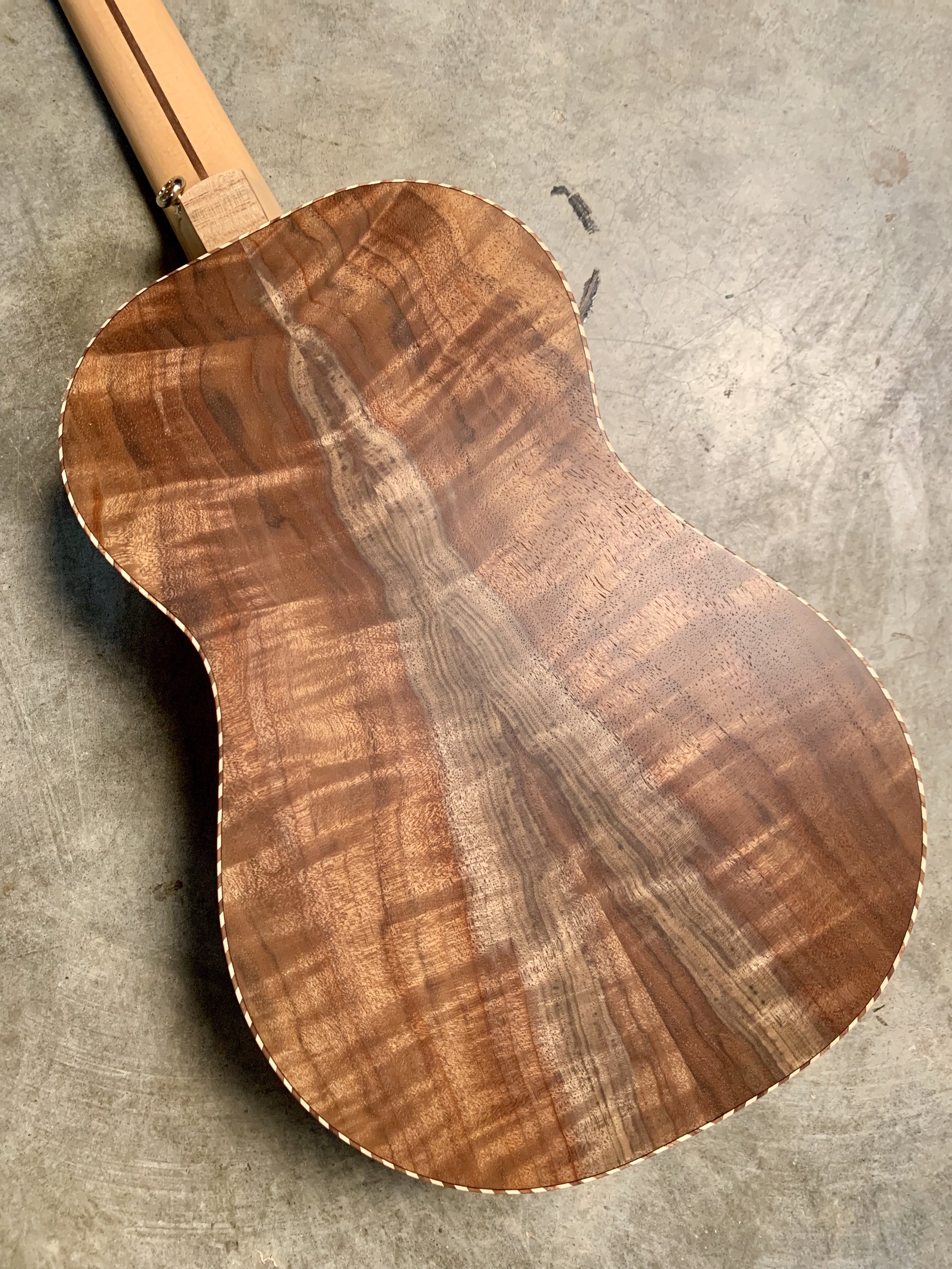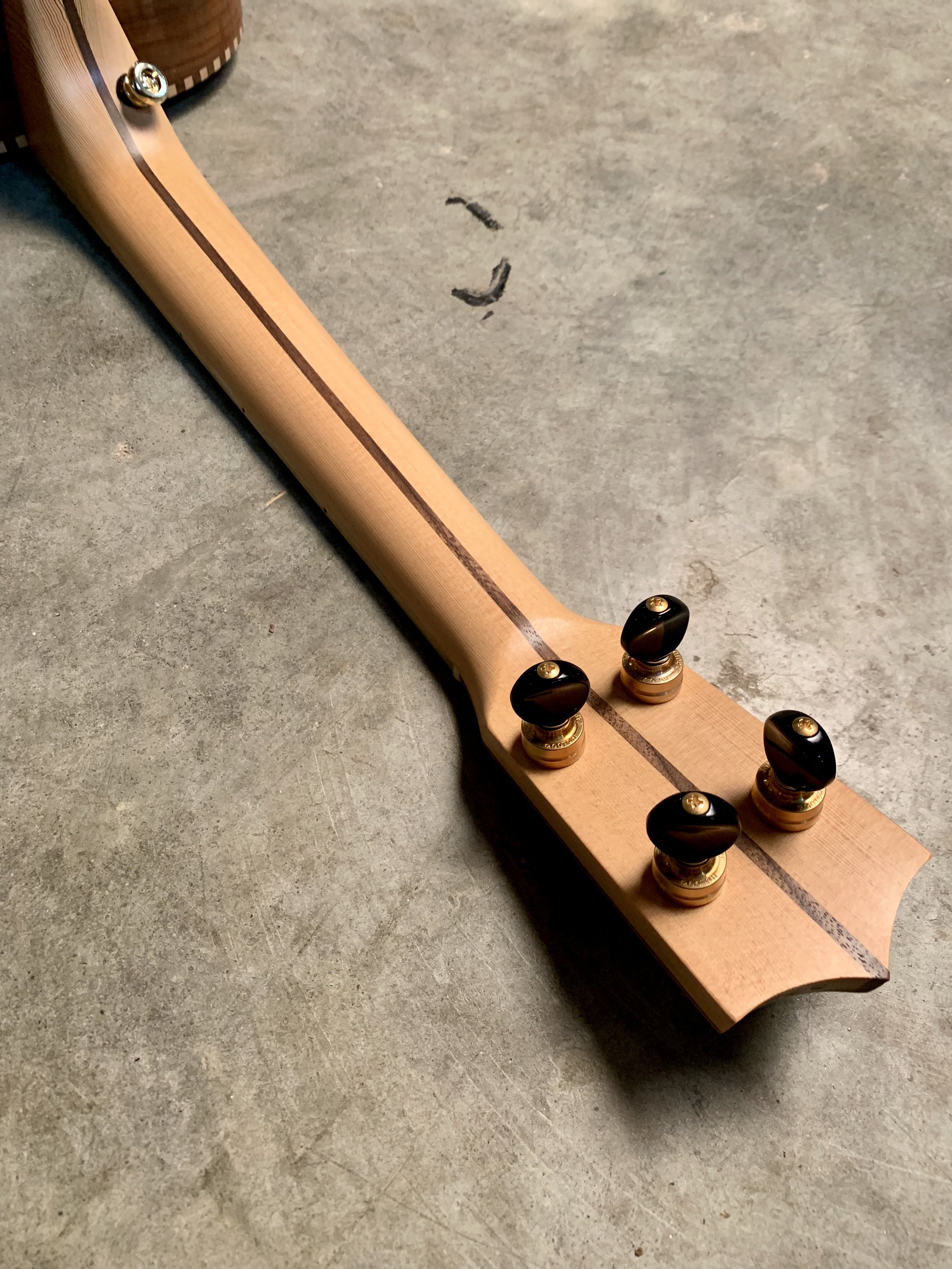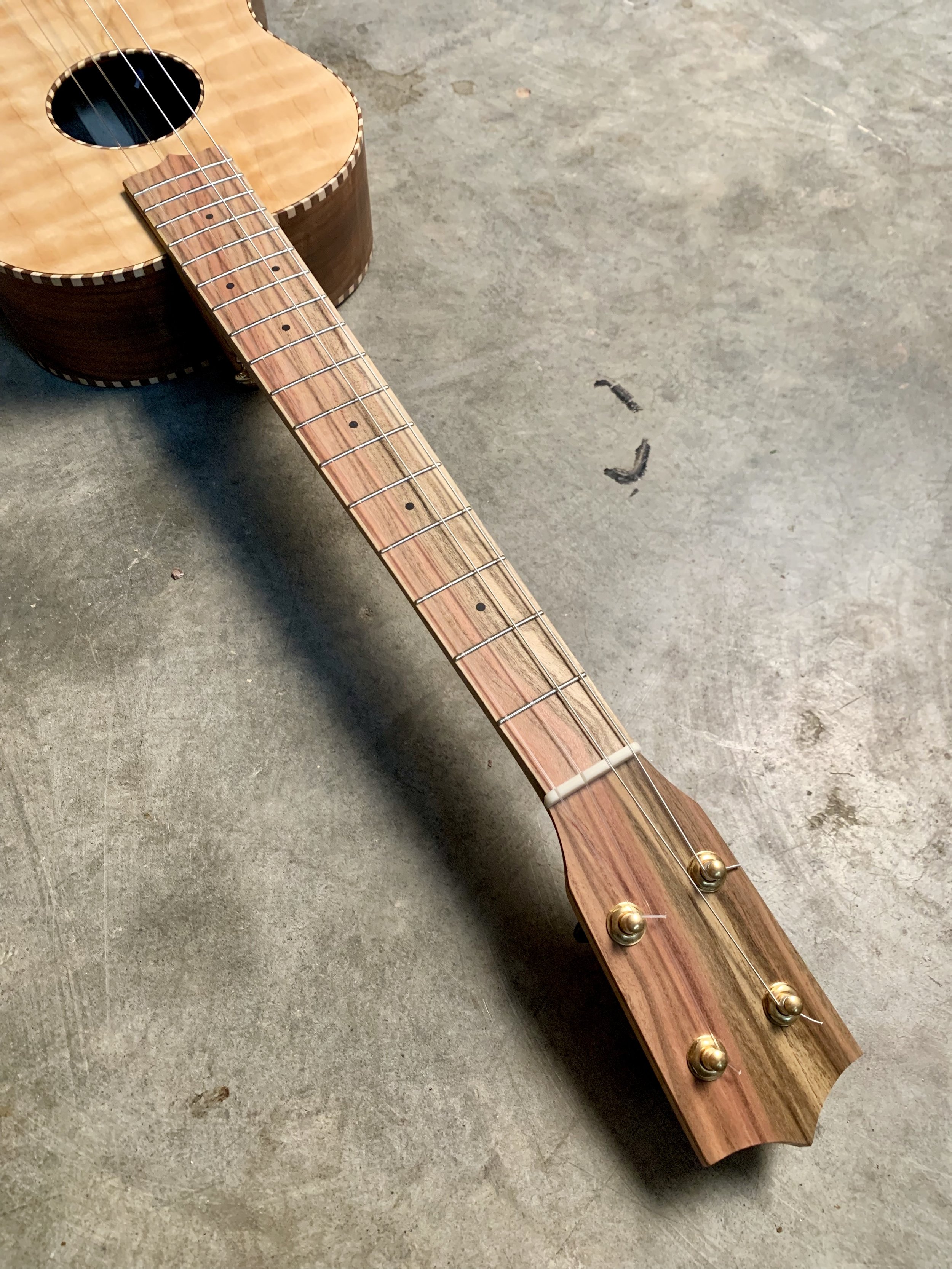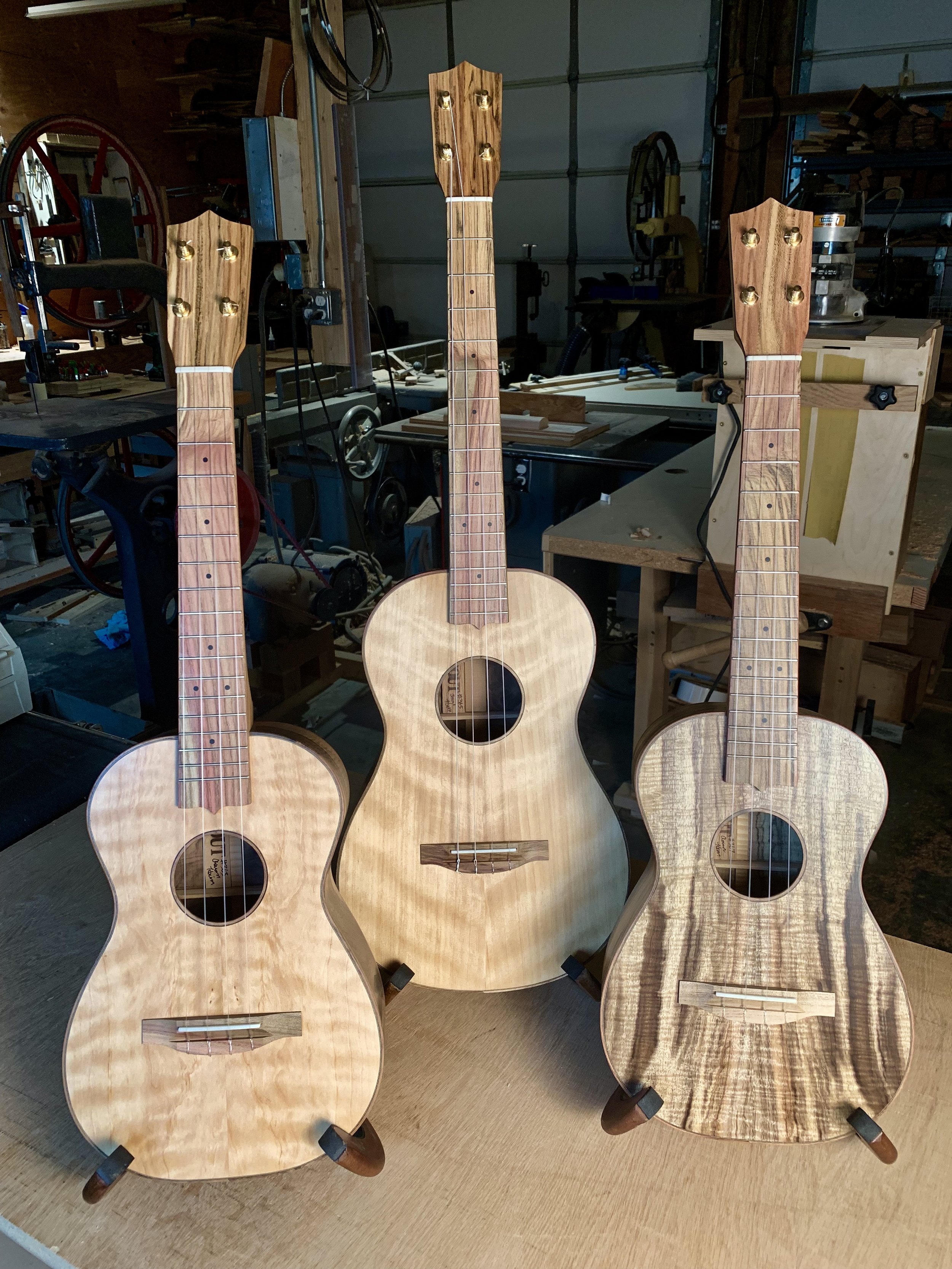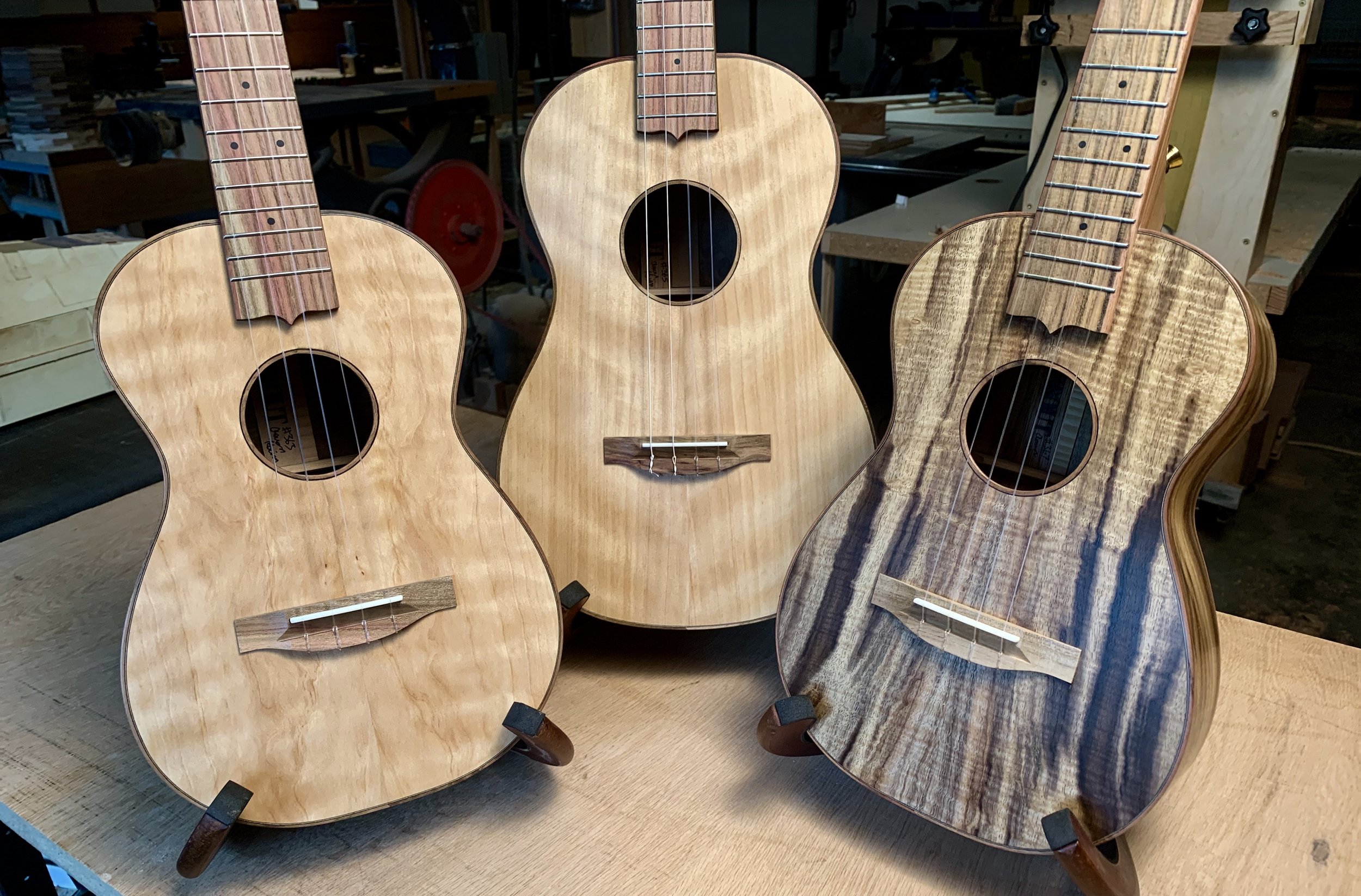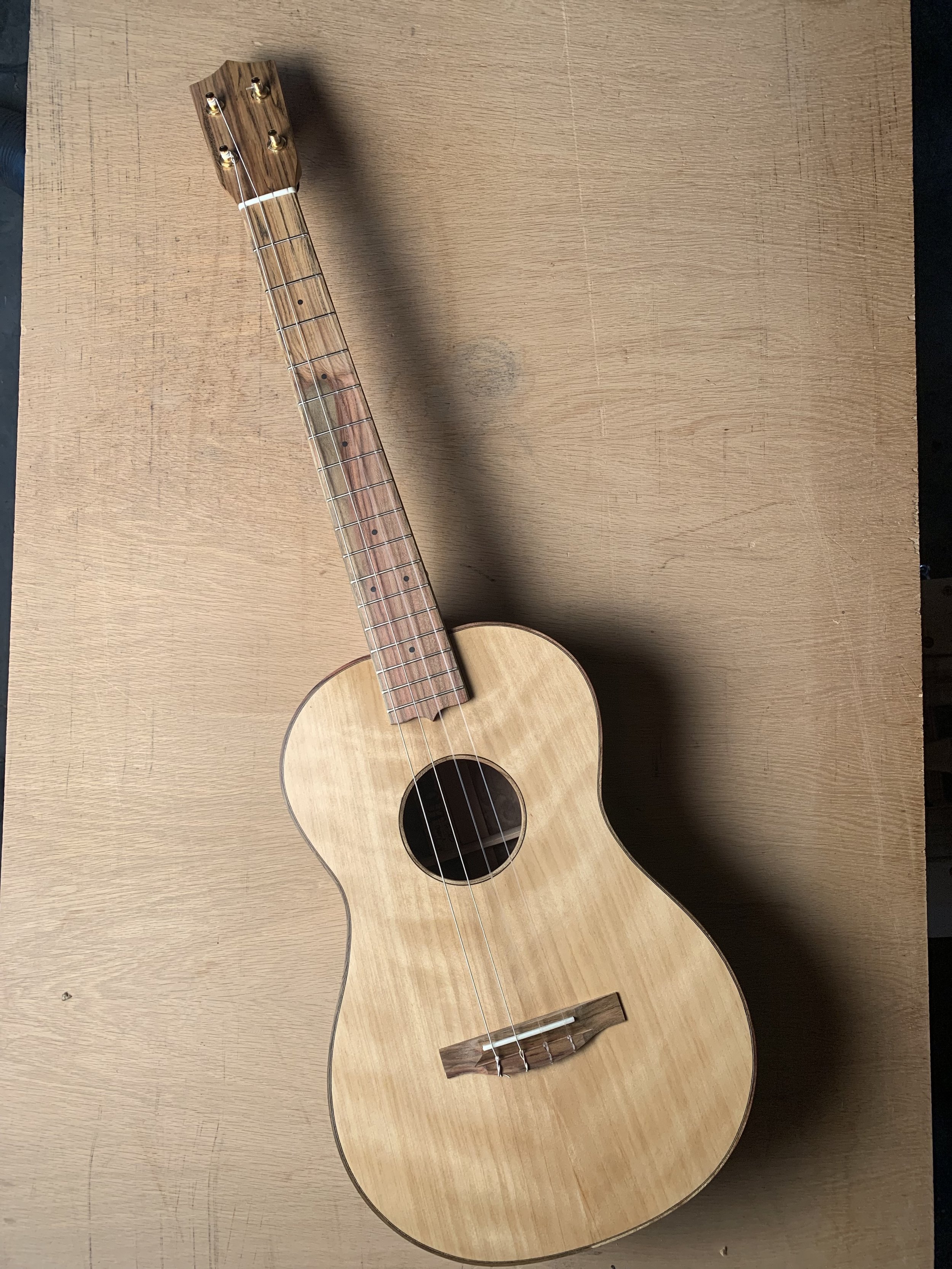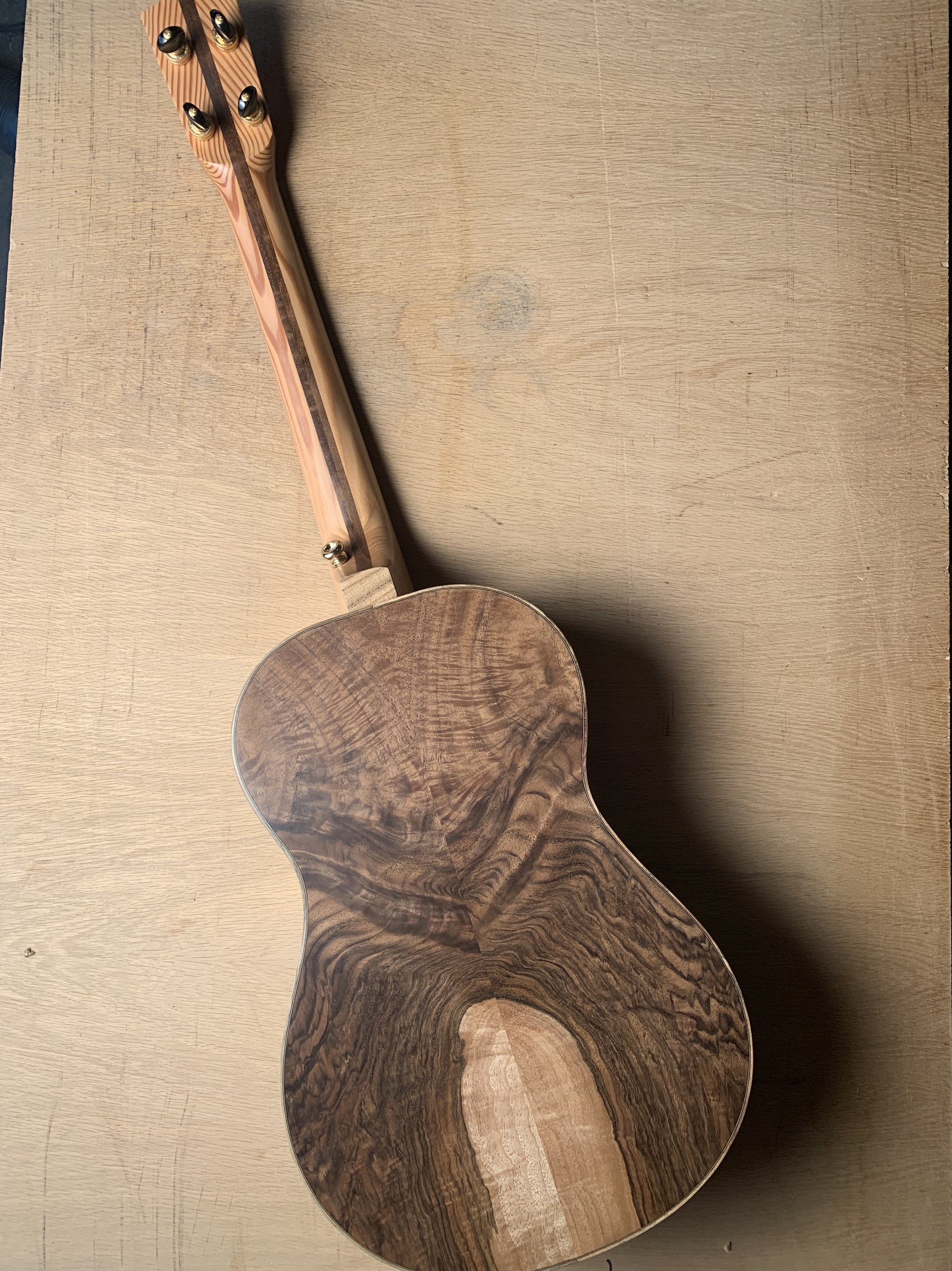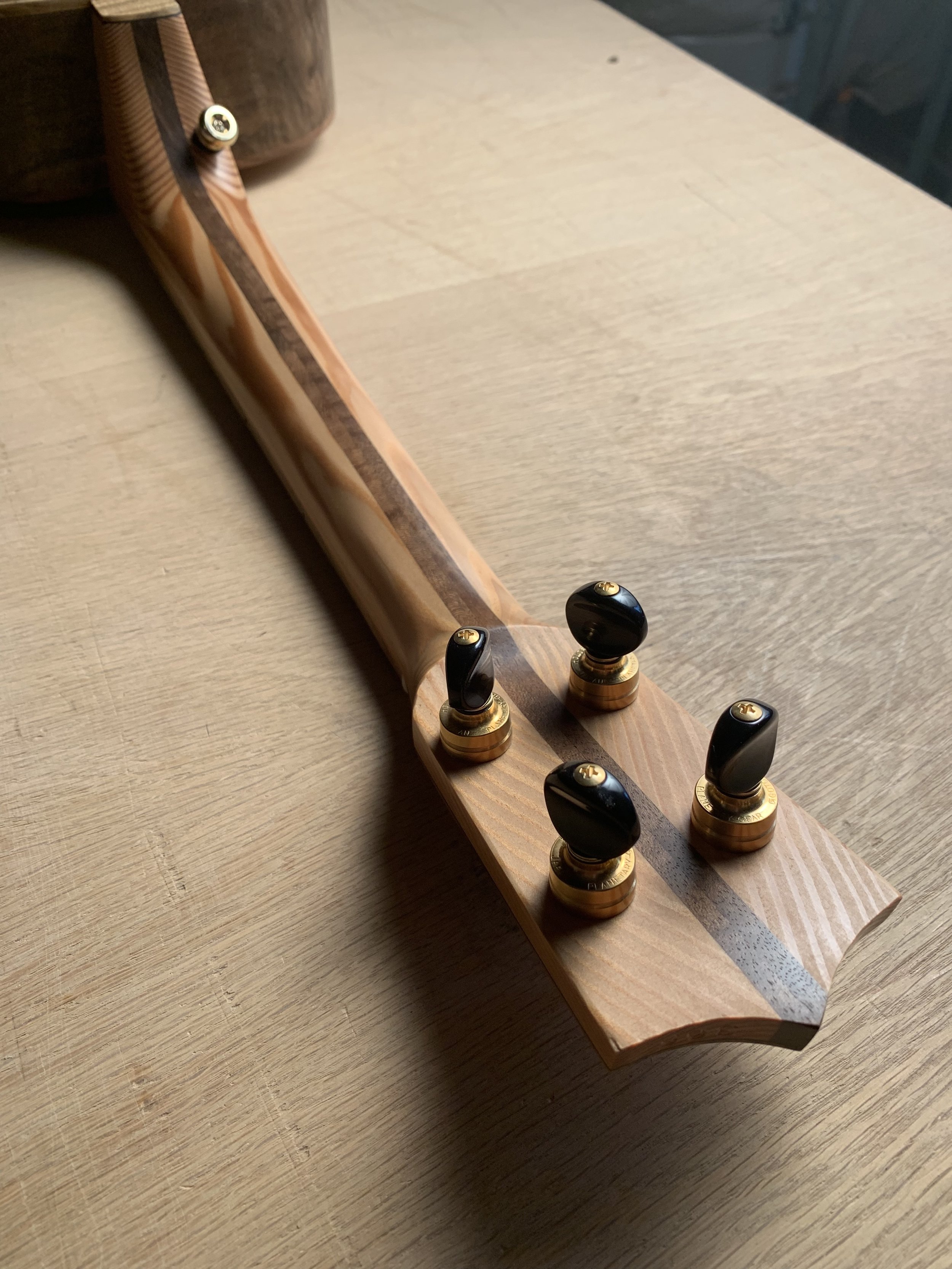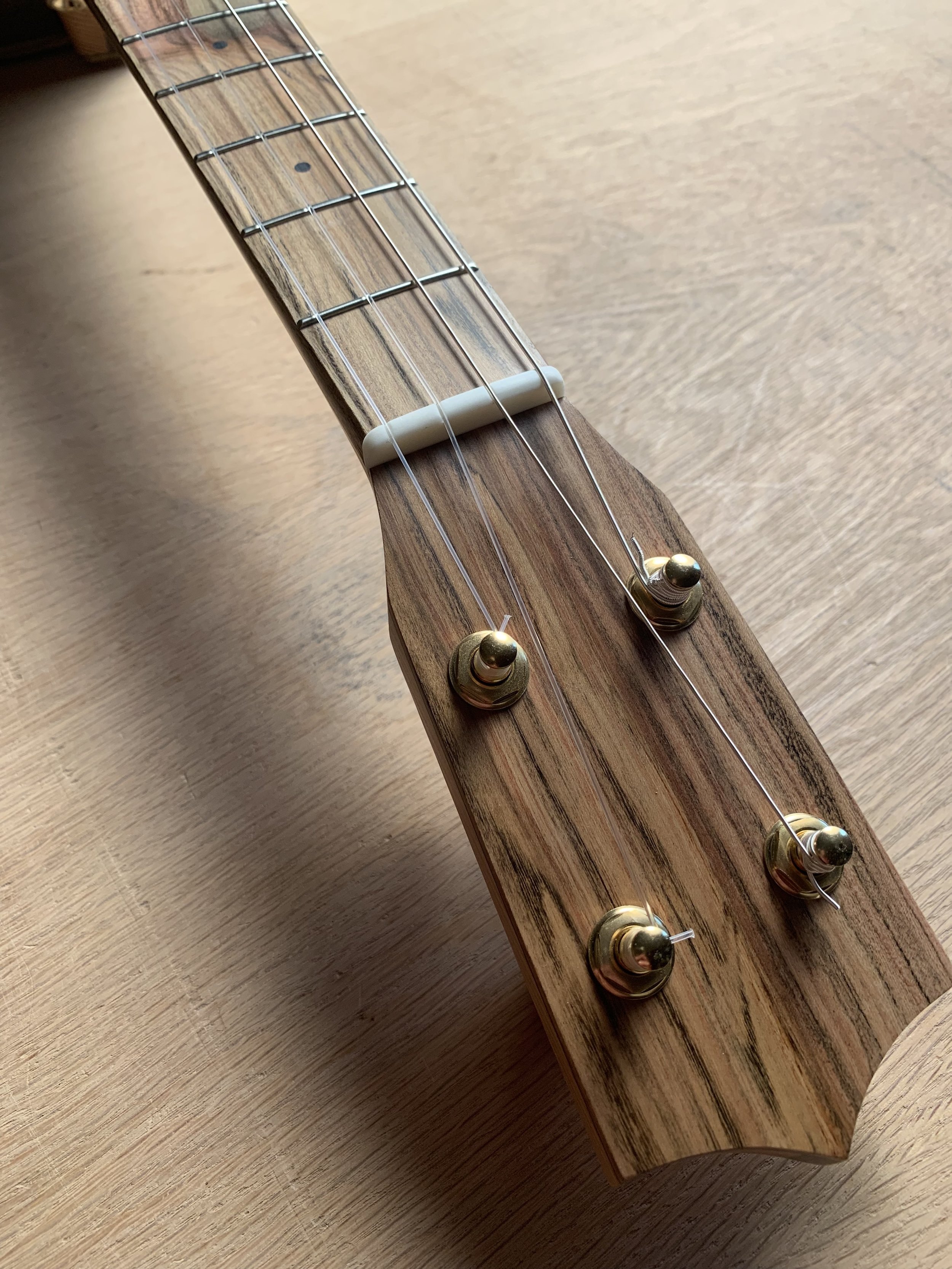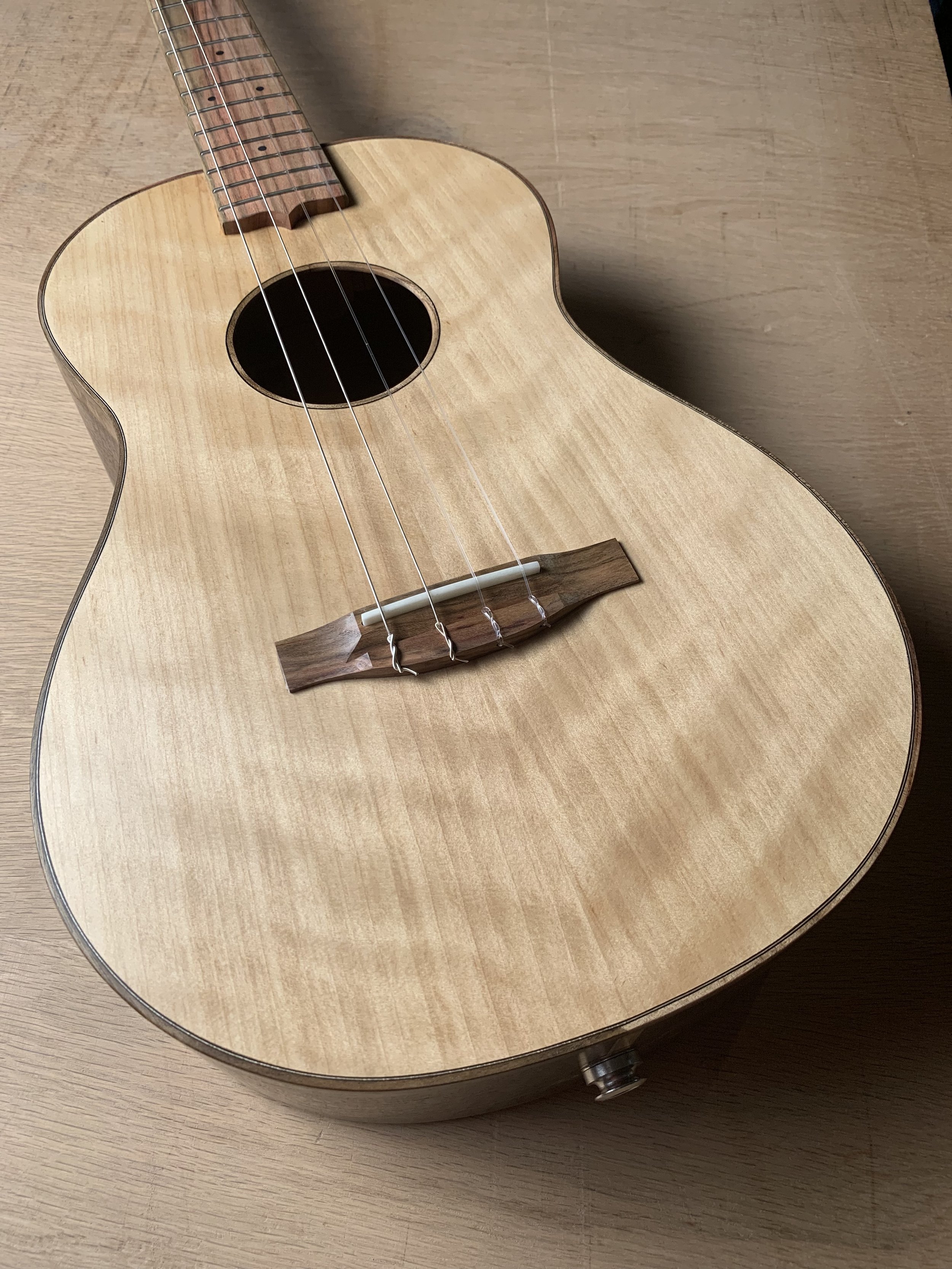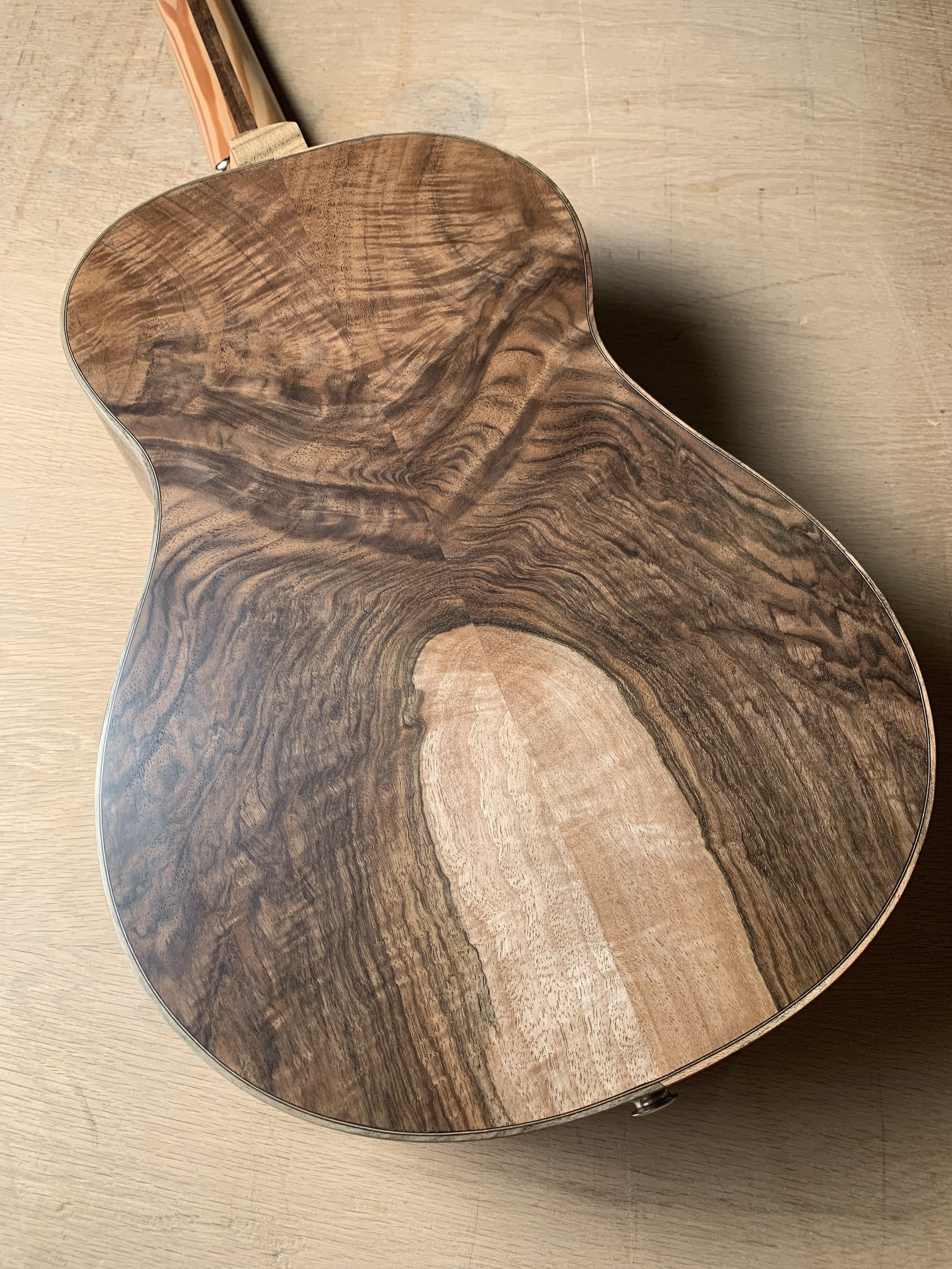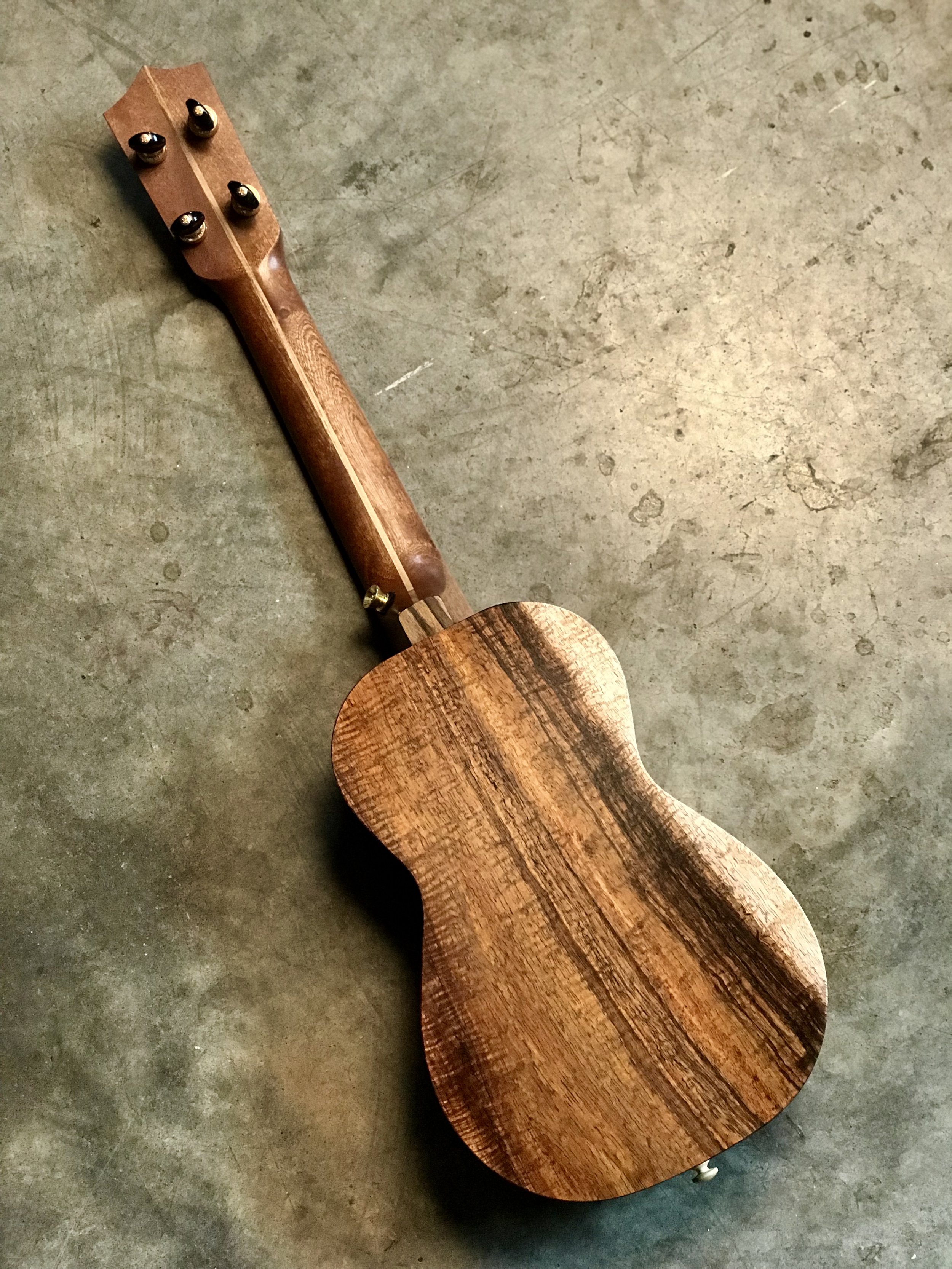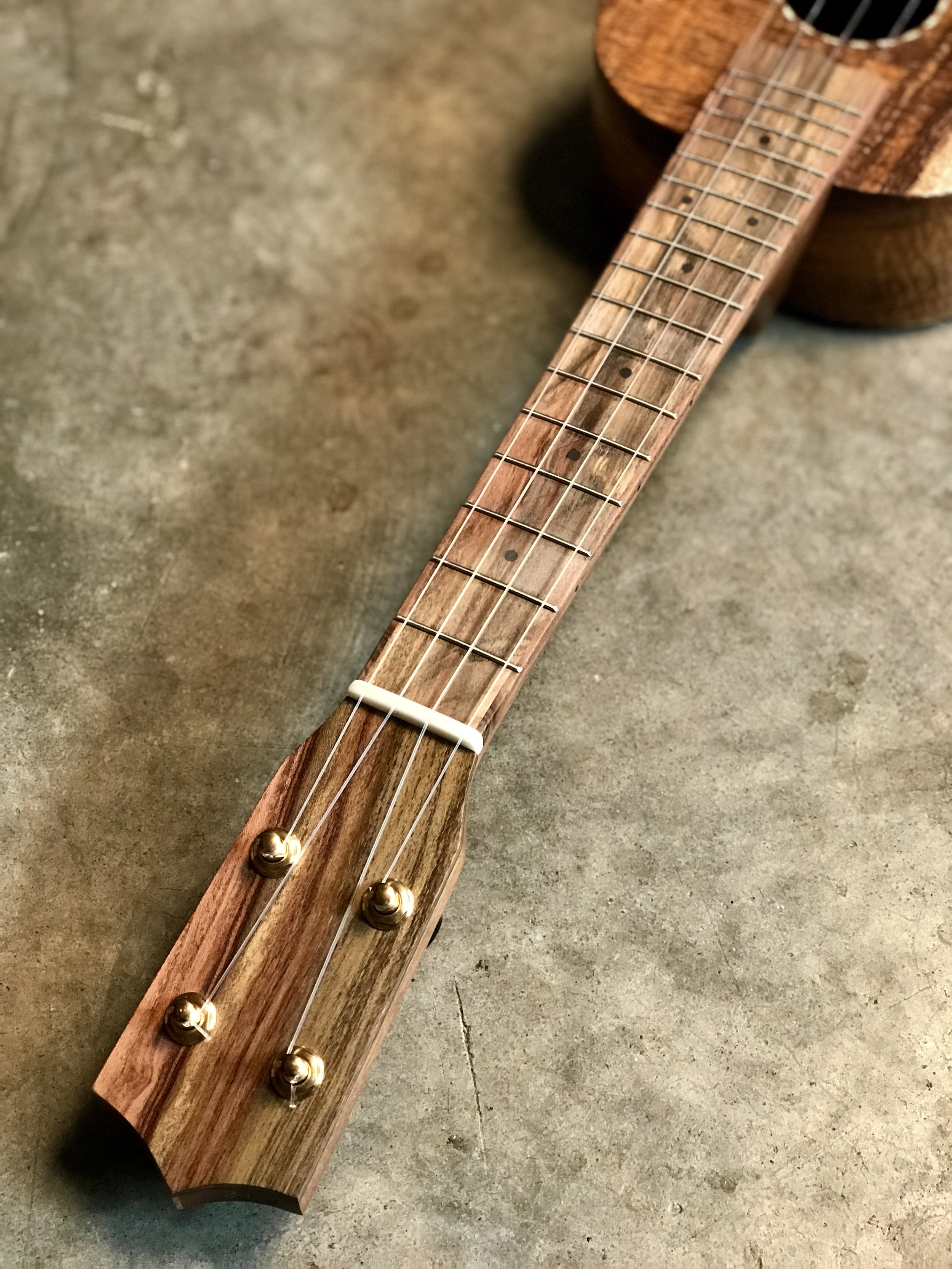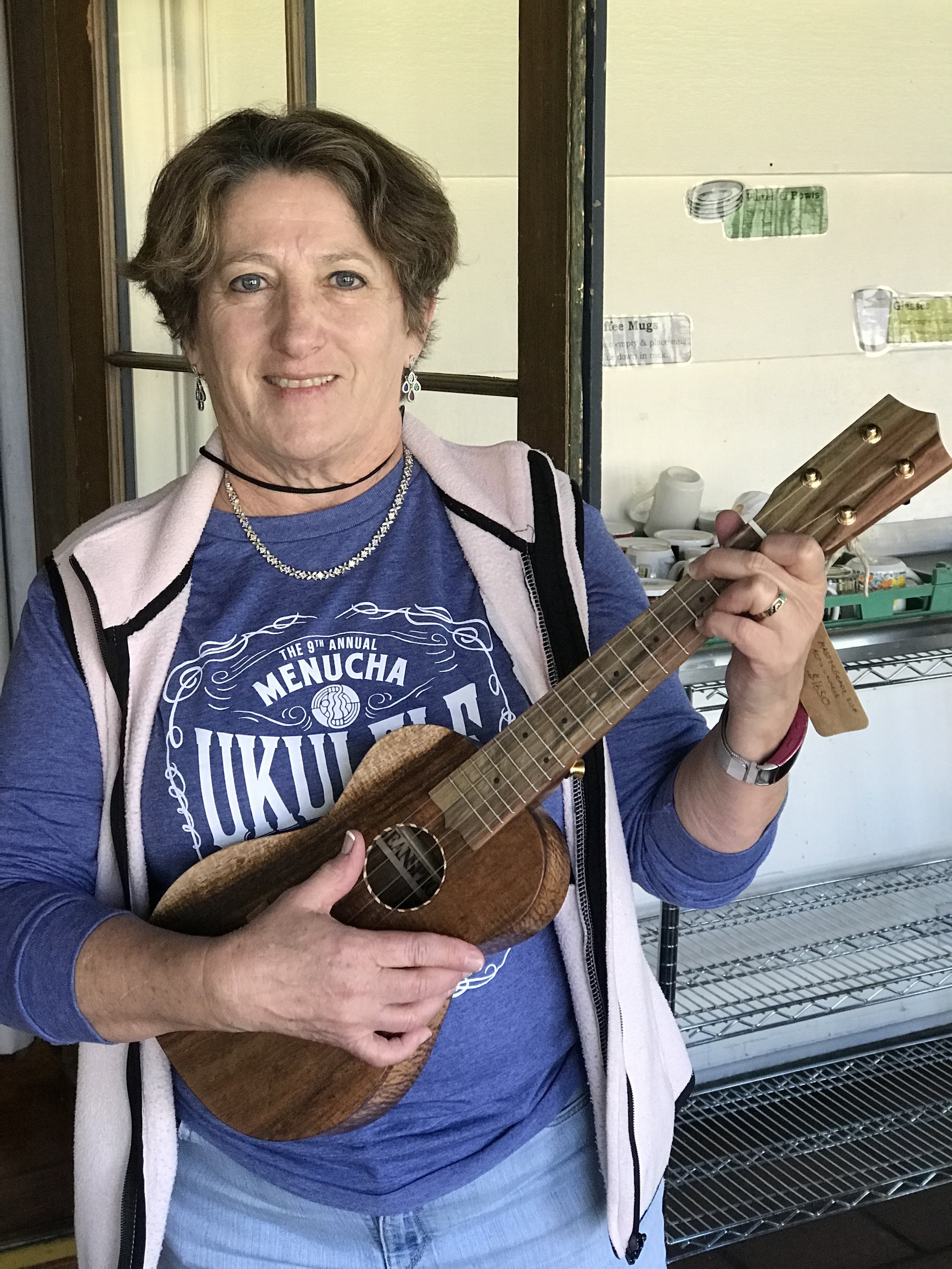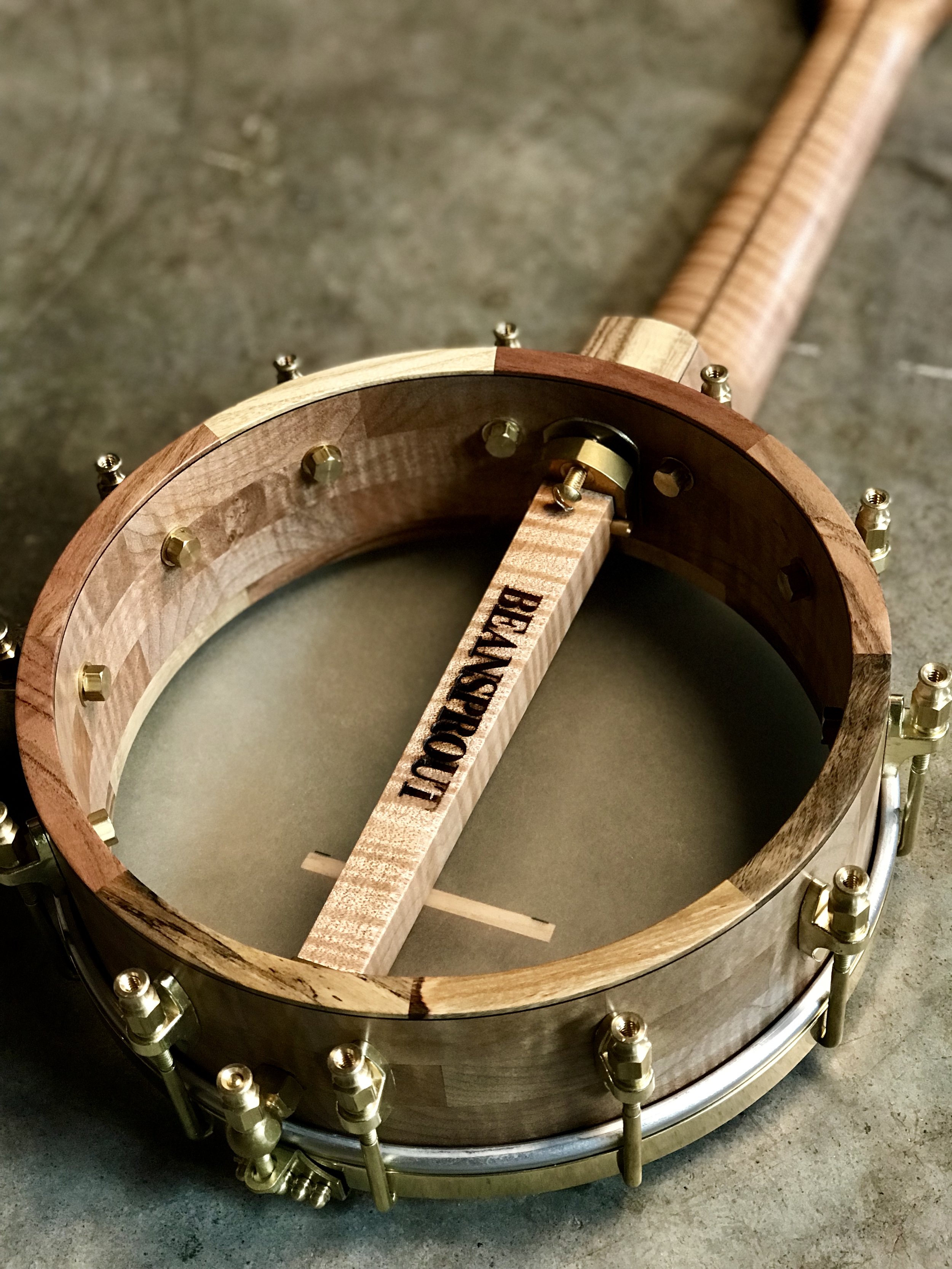I love Myrtle! It’s local, beautiful and sounds great. This set comes from the carpenter ant stash in Portland. It was a bit of a surprise that we found some Myrtle there. It luckily ended up looking really unique, with irregular flame and curl. It also has some lovely knots and dark streaks. Adam was wise to leave the binding and rosette off, it doesn’t need it. The neck is salvaged hemlock from Portland Salvage Works and the pistachio fretboard is from woodfromthewest.com.
#381- Spruce and Cherry Alto Ukulele
First off, see the below post about music/craft/community, as it also applies to this uke!
For this alto, Jeri came to the shop and picked out some nice pieces of wood. The top is Oregon spruce from Camp Westwind, the gnarly cherry back and sides are from the Carpenter Ant stash, the mahogany neck is salvaged from a furniture maker and the pistachio comes from California orchards. Compared to the more earth tone look and breathy sound of Jann’s uke below, this one has a crisper look and sound that I also like. It is pretty hard to hear the difference on the video but it’s something I can feel when I play, although it’s pretty subtle.
#377- Port Orford Cedar and Myrtle Alto Ukulele
Today I really feel inspired by the community we are connected to with our music and our craft. This instrument is built for our friend/student Jann, using wood from our friend/student Lizann’s father’s wood stash. Lizann and Jann play music together and will soon be playing instruments made by the same maker from wood collected by the same man. Next weekend, I am going to Portland to teach them an arrangement I wrote of an old jug band waltz and we will all make music together. I don’t know if the art/music/craft makes the community or the other way around, but I like it. (all this applies to Jeri’s uke in the next post as well, btw)
The myrtle is from a funky board from the Carpenter Ant stash and seems to have a gnome hiding in the back. The top is some striped Port Orford Cedar which came from the Oregon coast courtesy of woodfromthewest.com. The fretboard, headplate, bridge and bindings are pistachio from California orchards. The neck are fir floorboards with cherry lamination stripes. This instrument is a good example of the muted earth tones that are a hallmark of the wabi-sabi aesthetic. From far away, they blend together, up close you notice subtle differences.
#366- Myrtle Scout Uke
Inspired by the Lyon and Healy “camp uke” from the 1920’s-30’s, the Scout is a handmade ukulele with a simple design, sweet tone, easy playability and maximum portability. This one has an Oregon Myrtle body, old growth Douglas fir neck and pistachio everything else.
#371- Spruce and Oak Tenor Ukulele
Quarter-sawn white oak such as this is common in the furniture trade and was also used in parlor guitars, mandolins and banjos at the turn of the 20th century. To my ears, it has the volume of maple but a dustier sound, more old timey in a way. I paired it with a spruce top, pistachio fretboard, headplate and binding from California orchards and a fir floorboard neck. This oak is from the Carpenter ant stash in Portland and I have more like it. Drop me a line if you would like it in a uke or a banjo.
#376- Fir and Curly Mahogany Alto Ukulele
I really was going for a classic look on this uke, reminiscent of mainland designs of the 1920’s. The curly mahogany on the back and sides looks like some of my favorite higher grade Harmony ukes and the rope binding ties it to West coast builders like Knutsen and Weissenborn. The old growth Douglas fir top and pistachio head plate and fretboard are my updates, of course. The fir is salvaged from floorboards, the pistachio is from California orchards and the mahogany came from Char at Mya-Moe before she retired.
“
I just wanted to tell you how much I love my alto Beansprout. It is the perfect size for me. It was such a good decision to go ahead and buy it at the festival. Everyone who sees it admires it. My alto has incredible tone and great action. It is hard to believe that an instrument that small has such great tone!
I hope this all of you doing well and happy.
With kindest regards and great appreciation,
- C. W. ”
#378- Walnut and Pistachio Mini Five String Banjo
When I first imagined this little banjo design, I though it would be most useful in a higher tuning, like a piccolo banjo. But, it seems to have found its niche in standard g tuning. It makes for a small and pleasant version of a normal banjo. Easy to travel with, fits on a lap easily, easy on your back and hands. The walnut neck on this one is lightly curly stuff from Goby in Portland. The rim is mosaic of scrap pieces from the cutoffs from earlier banjos. It makes for a truly unique rim with lots of asymmetrical layers and a striking visual appeal. The pistachio is from woodfromthewest.com.
“Just to let you know, #378 arrived yesterday, and it is a thing of real beauty! I really appreciate the craftsmanship, the attention to detail, the selection of beautiful woods, and most especially, the extremely satisfying sound of it. I am absolutely thrilled with it. Keep up the great work, both of you!
- M. M. ”
#380- Maple and Pistachio Tenor Banjo Ukulele
Dana asked for a tenor scale banjo uke tuned cgda, like a Tenor Banjo. We tested some different string gauges and were surprised by the good sound. I find this setup, especially when played with a pick, to be a lot of fun. The tone is rich and dark but with the sparkle and punch Maple is known for. I can’t wait to see what Dana uses it for. The maple is hard, straight grain stuff from Henry’s dance floor stash and the pistachio is from California orchards.
#373- Port Orford Cedar and Walnut Baritone Ukulele
Have you ever had the experience where you hear a new word and suddenly it is everywhere? With this ukulele, it happened with the cool knot in the fretboard that looks like the eye of Horus. It then showed up in the neck and in the knots in the back. A nice bit of synchronicity that happened during wood selection. The top is Port Orford Cedar from the Oregon coast, walnut is urban salvage from Goby in Portland, the fir neck was a floor joist in Portland and the pistachio is from California orchards.
#378 Maple and Pistachio Five String Banjo
This instrument shows me experimenting a bit, admittedly within the narrow guidelines I give myself to stay on brand. It is my normal five string banjo, but with two main changes. 1st, I stained the maple a nice reddish brown. 2nd, I added a small rolled brass ring to the top of the rim. Overall, I am quite pleased. I played it for a rehearsal today and liked the tone and feel of it. You can hear this banjo in the video below, compared to another with a different setup.
“Hi Aaron,
It’s here and I LOVE it. I’m new to the banjo world but it’s a million times better than what I’ve been learning on - louder, more complex, greater depth of tone and SO much more playable. Thanks for making such a beautiful instrument. I feel very privileged to be learning on something so special. I can’t put it down!!!!
- M.S.”
#374- Port Orford Cedar and Walnut Baritone Ukulele
I recently sold my ukulele to my friend Danielle. I needed another one for this month’s gigs so I got right to it. I was inspired by the simple sap wood streak in the back and sides to keep everything else simple too. Tight grain spruce top, no front dots on the two tone pistachio fretboard, no rosette or sound hole binding. I used multi colored pistachio binding to mimic the streak on the back. The neck is a fir floor joist from the Level beer property in Portland. The walnut is from Goby and the Port Orford Cedar and pistachio are from woodfromthewest.com.
#375- Walnut and Pistachio Concert Banjo Ukulele
Oregon walnut with a subtle curl, multi colored pistachio, raw brass and textured natural goat skin. It seems that these aren’t just musical instruments, they are also mixed media works of folk art. Yes, I am always trying to perfect each step and raise the quality level, but the hand made touches, natural flaws and contrasting textures keep it humble. What was once a pile of raw materials is now ready to sing. Walnut from Goby and pistachio from California orchards.
#372- Curly Port Orford Cedar and Curly Walnut Baritone Ukulele
Sometimes when you select a rough board, you can imagine exactly how it is going to look under finish. Sometimes, it’s a surprise! In this case, the walnut back and sides were much fancier looking than I anticipated. Bonus! The Curly Port Orford Cedar top looks amazing and gives a balanced voice to this Baritone. The Oregon walnut is urban salvage from Goby, the pistachio and POC come from woodfromthewest.com, the neck is salvaged old growth hemlock.
#361- Curly Port Orford Cedar and Mastergrade Myrtle Tenor Ukulele
Sometimes a hole in the shop schedule allows me to make an instrument to my specs and offer it as a stock instrument for immediate sale. I love this process because I get to pick everything and maybe even experiment a bit. In this case, I enjoyed the dissonance of paring this amazing Mastergrade Myrtle and curly Cedar with a fir neck that has several filled nail holes. The fir came from a floor joist from a barn and I filled the nail holes with oak dowels before I carved the neck. I see the neck as a symbol of the scarred beauty of each person in the world. Of course, it is a 100% functional ukulele, but I want to find an owner for it that is up for a long term relationship with me, keeping me posted on how the neck changes over time with use. (Don’t forget, the visible passage of time from use is an important part of the Wabi-Sabi idea.) The Myrtle, Cedar and pistachio for this build are from woodfromthewest.com
A trio of ukuleles.
A set of three ready for Carla and Ryan. It was a real honor to work on great instruments like this. I can’t wait for them to make music!
#365- Port Orford Cedar and Walnut Baritone Ukulele
The baritone Ukulele is a bit of a strange sibling to the Tenor. It is tuned to a lower pitch and often seems the odd one out at the Ukulele club. But, over the past four years, many pros have taken to them for their main performance uke because of the wide range and rich sound. You can always put a capo on it and strum it like a regular uke too. The cheaper 1960’s all mahogany baritone is usually dark and quiet, the challenge is to make a baritone that projects it’s sound and has a rich deep voice. This one uses Port Orford Cedar, grafted walnut and grafted pistachio from woodfeomthewest.com. The fir neck is made from salvaged floor boards.
#367 Mastergrade Myrtle Tenor Ukulele
This is another breathtaking example of how lucky I am to work with Oregon Myrtle. This mastergrade set looks spectacular, is easy to work and has a lovey balanced tone and volume. The Myrtle tenor has long been a flagship instrument for me and I don’t see that changing anytime soon. The Myrtle and pistachio come from woodfromthewest.com and the fir floorboards for the neck come from a barn in The Dalles, provided by Portland Salvage Works.
#362 Mastergrade Koa Alto Ukulele
I have a special stash of wood that I got from Char at Mya-Moe when she retired. She went around the shop and selected a few of her favorite sets for me to use in the future. This asymmetrical super Curly koa includes a beautiful bit of sap wood on the edges to really make it look unique. I paired it with a salvaged mahogany neck and a relatively subdued pistachio fretboard. I decided to leave the binding off in order to let the koa shine without getting in the way. It has a dark and sweet sound, I’m happy it found a home with our friend Michelle.
#368- Curly Maple and Pistachio Concert Banjo Ukulele
Come on people, look at that curly maple! What a treat it was to lay out the rim segments and the neck on this one. It’s hard to go wrong, just get out of the way and let the wood show you how to do it. Maple gives a bright and clear tone and is a traditional favorite for banjo makers. This maple is from the Carpenter Ant Stash in Portland and the pistachio comes from California orchards.
““I am so thrilled with my new Beansprout banjo ukulele! I had high expectations before receiving my banjo uke, and it has exceeded all of them. The craftsmanship is excellent, the wood is breathtaking, the neck is perfectly shaped, and the uke is responsive and effortless to play and has a full and resonant, but still banjolike, sound. I appreciate Aaron’s commitment to using sustainable sources for wood, and I like knowing both the source and the story behind the wood that was used to make my uke. I could not be happier with my experience with Beansprout or with my banjo uke, and I am already planning my next Beansprout ukulele purchase!””
#364- Bearclaw Spruce and Pistachio Baritone Ukulele
I don’t take the time to look at the materials as much as I ought too. It’s often the customer who comes back to me and points out the best natural features and notices the synchronicities in my improvisational wood layouts. I am just following my instincts to make good choices as I work to get the instruments out on time. In this case, I have to admit that this Bearclaw Spruce top from Alaska Specialty Woods slayed me. I actually stopped in the shop yesterday and just breathed and looked at it in the natural light. Flipped it over and checked out the grafted pistachio back from woodfromthewest.com. What is happening here? How do trees look like this? The fact that we get to use these special slices of our natural world to make music is even better. What an absolute blessing.

